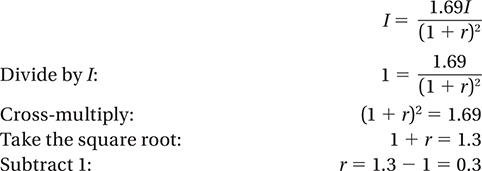
ANSWER SHEET for PRACTICE TEST 3
Use a No. 2 pencil and fill in the entire circle darkly and completely. If you change your response, erase as completely as possible

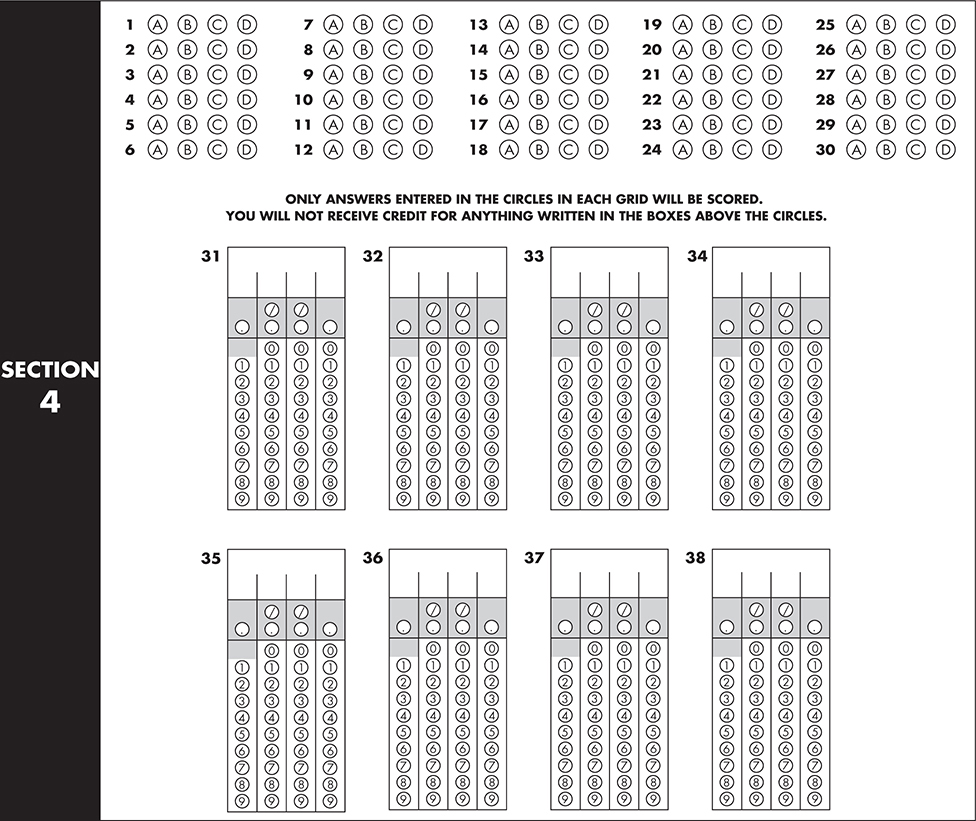
Test begins on the next page.
Reading Test
65 MINUTES, 52 QUESTIONS
Turn to Section 1 of your answer sheet to answer the questions in this section.
DIRECTIONS
Each passage or pair of passages below is followed by a number of questions. After reading each passage or pair, choose the best answer to each question based on what is stated or implied in the passage or passages and in any accompanying graphics (such as a table or graph).
Questions 1–11 are based on the following passages and supplementary material.
Passage 1 is from F. J. Medina, “How to Talk about Sustainability.” ©2015 College Hill Coaching. Passage 2 is adapted from an essay published in 2005 about the economic analysis of environmental decisions.
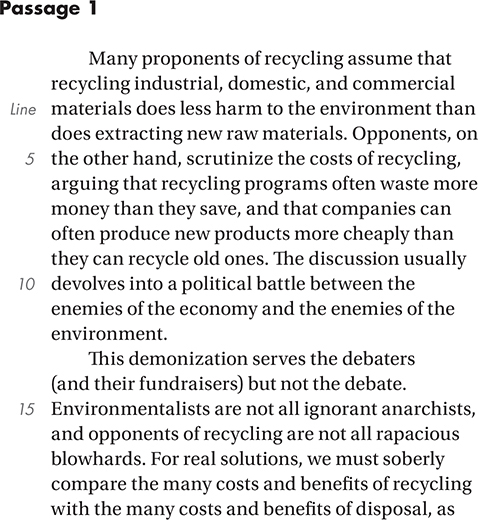
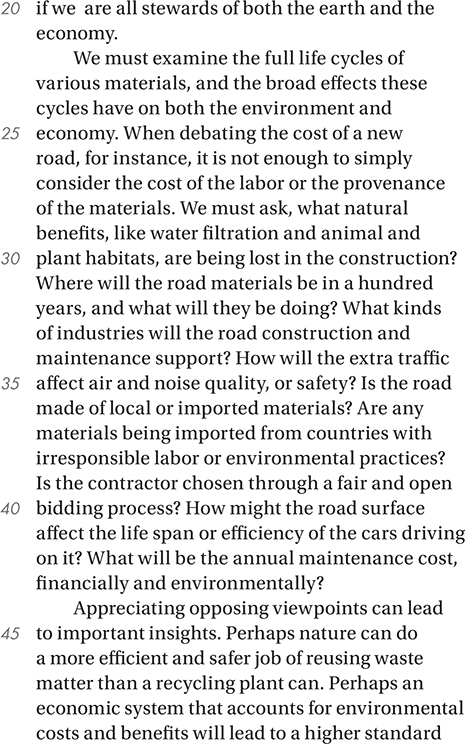
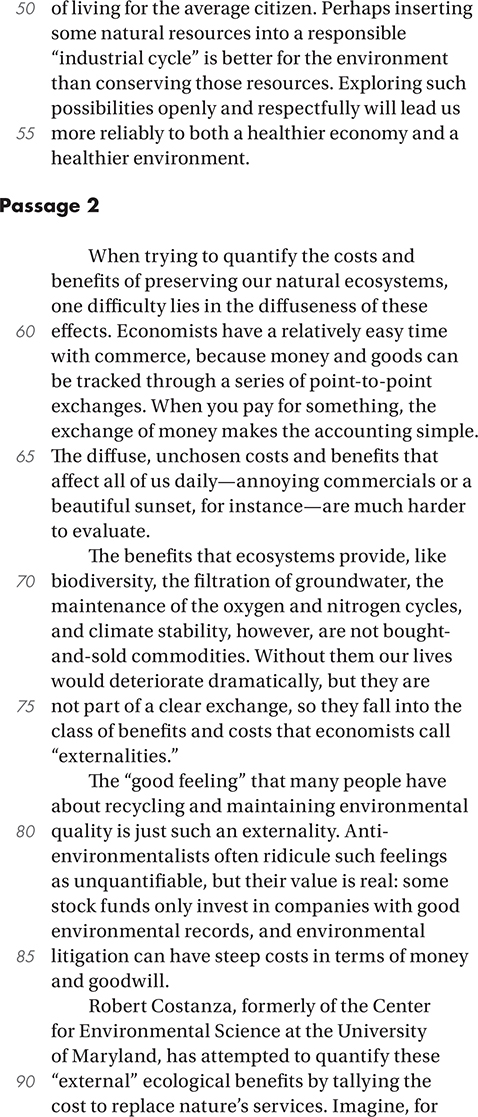
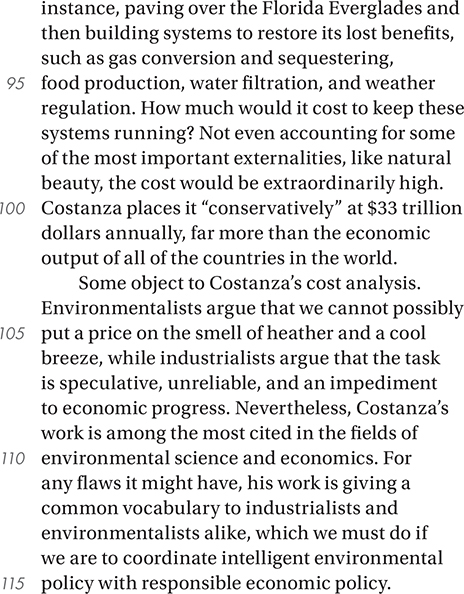
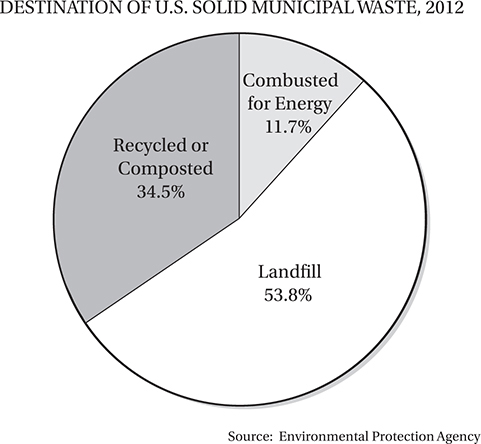
The first two sentences of Passage 1 serve primarily to
A) provide historical background to a debate.
B) establish the author’s central thesis.
C) define terms for a technical discussion.
D) characterize opposing viewpoints.
The repetition of the phrase “not all” in lines 15 and 16 emphasizes the author’s point that the “debaters” (line 13) tend to
A) mischaracterize their opponents.
B) discount evidence that does not support their positions.
C) employ self-contradicting arguments.
D) overlook relevant personal anecdotes.
The phrase “life cycles” (line 22) refers most directly to the
A) reproductive and feeding habits of local plants and animals.
B) variability in public perceptions about recycling.
C) global economic trends that affect industrial production.
D) processes that affect the substances used in manufacturing.
In line 50, “inserting” most nearly means
A) installing.
B) imposing.
C) introducing.
D) interjecting.
Which choice would the author of Passage 2 consider to be a direct effect of “natural ecosystems” (line 58)?
A) The “real solutions” (line 17)
B) The “provenance of the materials” (lines 27–28)
C) The “water filtration” (line 29)
D) The “maintenance” (line 34)
Which of the following policies would most likely be endorsed by the author of Passage 1?
A) Tax incentives for companies that recycle their waste products
B) Sanctions against nations that permit slave or child labor
C) Limits on factory emissions that contribute to acid rain
D) Public investment in sustainable domestic energy sources
Which choice provides the best evidence for the answer to the previous question?
A) Lines 28–30 (“We . . . construction?”)
B) Lines 32–34 (“What . . . support?”)
C) Lines 36–38 (“Are . . . practices?”)
D) Lines 40–42 (“How . . . it?”)
The diagram provides information most relevant to
A) Passage 1, because it indicates the scale of “recycling programs” (line 6).
B) Passage 1, because it illustrates the “many costs and benefits of disposal” (line 19).
C) Passage 2, because it represents the “benefits that ecosystems provide” (line 69).
D) Passage 2, because it shows “some of the most important externalities” (lines 97–98).
Which choice best exemplifies the “clear exchange” (line 75) mentioned in Passage 2?
A) The “debate” (line 14)
B) The “natural benefits” (line 28–29)
C) The “maintenance cost” (line 42)
D) The “important insights” (line 45)
Unlike Passage 2, Passage 1 specifically discusses
A) the effect of a particular rhetorical strategy.
B) the quantification of particular externalities.
C) the popularity of a particular environmental policy.
D) the cost of preserving particular environmental benefits.
Passage 2 compares the viewpoints of “environmentalists” and “industrialists” primarily to point out that
A) disputes about environmental policies are deep and intractable.
B) careful examination of externalities is controversial but necessary.
C) many debates about environmental issues are needlessly politicized.
D) both parties must learn to focus more on economic issues than environmental ones.
Questions 12–21 are based on the following passage.
This passage is from Cait Featherstone, Earth, Song and Sky Spirit: Shadows and Sleepwalkers. ©1992 by Random House, Inc.

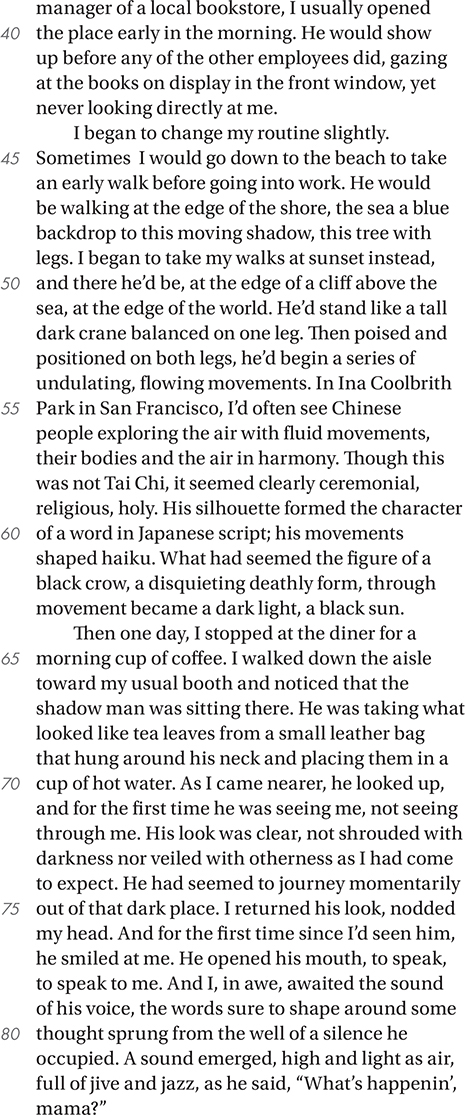
The purpose of the passage as a whole is to
A) describe a relationship between friends.
B) portray the character of a small town.
C) recount an episode in the narrator’s self-discovery.
D) chronicle a preoccupation with an enigmatic figure.
The many stories that circulated about the stranger are best described as
A) uniformly macabre.
B) strangely entertaining.
C) playfully deprecating.
D) decreasingly speculative.
Which choice provides the best evidence for the answer to the previous question?
A) Lines 9–10 (“Maybe . . . venture”)
B) Lines 14–16 (“Eventually . . . fact”)
C) Lines 17–18 (“Soundlessly . . . things”)
D) Lines 25–27 (“Was . . . ended?”)
In line 25, “moonscape surface” refers to
A) a desolate aftermath.
B) an unexplored vista.
C) an idyllic location.
D) a primordial stage.
In line 59, “character” most nearly means
A) visible symbol.
B) abstract quality.
C) strange person.
D) moral integrity.
In lines 30–43, the narrator’s encounters with the stranger are notable for their
A) incongruousness.
B) ominousness.
C) ubiquity.
D) sentimentality.
Throughout the passage, the narrator describes the stranger’s physical characteristics chiefly through the use of
A) literary allusions.
B) military comparisons.
C) avian metaphors.
D) exaggerated juxtapositions.
The phrase “what we would all come to know” (line 29) most likely refers to
A) the identity of the stranger.
B) the destiny of humankind.
C) the inhumanity of war.
D) a source of tranquility.
In line 74, the narrator indicates that the stranger “seemed to journey” from
A) foreign terrain to a familiar homeland.
B) grim memory to current experience.
C) vague obscurity to public recognition.
D) self-consciousness to self-confidence.
The first words the narrator heard from the stranger most likely made her feel a sense of
A) solemn respect.
B) surprised relief.
C) sudden dread.
D) deep tranquility.
Questions 22–31 are based on the following passage.
This passage is adapted from Mary Gay Humphries, “Women Bachelors,” an essay originally published in 1896. During the latter part of the American Industrial Era (c. 1840–1900), many unmarried women began migrating to urban areas throughout the country.
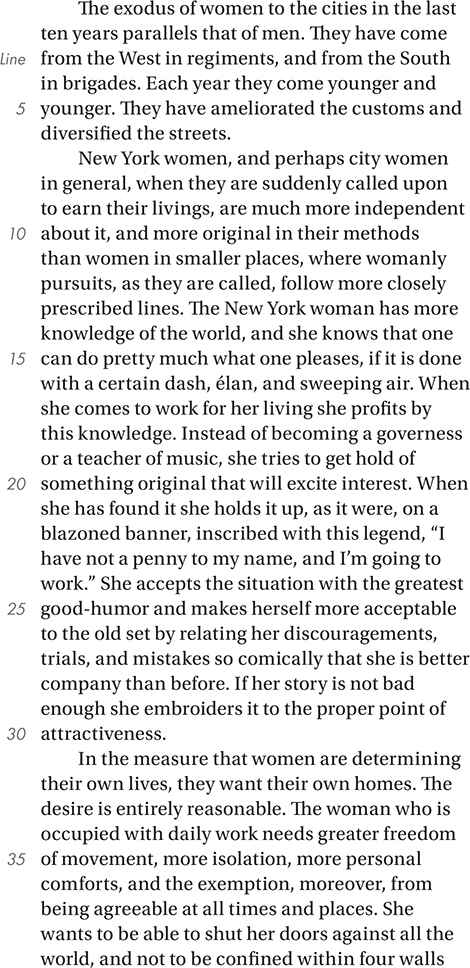
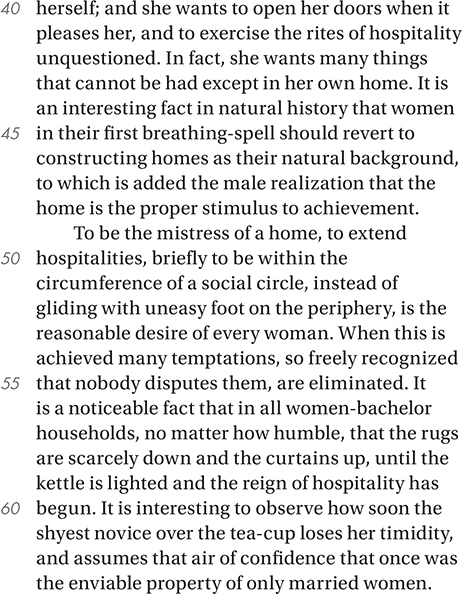
The first paragraph portrays the “exodus of women” (line 1) as
A) tentative.
B) regrettable.
C) inevitable.
D) transformative.
The author suggests that, compared to women living in urban areas, those living in rural areas are less
A) diffident.
B) humorous.
C) innovative.
D) traditional.
Which choice provides the best evidence for the answer to the previous question?
A) Lines 7–13 (“New . . . lines”)
B) Lines 13–16 (“The . . . air”)
C) Lines 17–18 (“When . . . knowledge”)
D) Lines 18–20 (“Instead . . . interest”)
The author suggests that, to the new urban woman, poverty is
A) a challenge to be embraced.
B) a career burden to be avoided.
C) the consequence of male dominance.
D) a surprising source of freedom.
Which choice provides the best evidence for the answer to the previous question?
A) Lines 24–28 (“She . . . before”)
B) Lines 31–32 (“In . . . homes”)
C) Lines 33–37 (“The . . . places”)
D) Lines 43–48 (“It . . . achievement”)
In line 16, “dash” most nearly means
A) propriety.
B) flair.
C) diligence.
D) haste.
As it is used in line 26, “old set” most likely refers to a group of
A) traditional gender roles.
B) established acquaintances.
C) historical ideals.
D) abandoned opportunities.
The passage indicates that city women want to maintain their own homes primarily because
A) they are naturally predisposed to performing domestic duties rather than having careers.
B) they should maintain a social status comparable with that of men.
C) they require living conditions conducive to their social independence.
D) they need ample space to do the work that is required of them in an industrial economy.
Which choice best summarizes the main point of the passage?
A) Women who are moving to the cities are subject to many unfair expectations and social burdens.
B) Traditional female duties, such as housekeeping, should be re-evaluated in the context of modern urbanization.
C) In modern times, the social independence of women corresponds to their desire to own and maintain a home.
D) Women who choose to live in cities are more creative and industrious than those who choose to live in rural areas.
The “exemption” mentioned in line 36 is
A) a reprieve from a social obligation.
B) an exception to a legal rule.
C) an anomaly among personal characteristics.
D) an irregularity within an established hierarchy.
Questions 32–42 are based on the following passage and supplementary material.
This passage is adapted from Alyson Shepherd, “The Promise of Immunotherapy and Oncolytic Virotherapy.” ©2015 by College Hill Coaching.
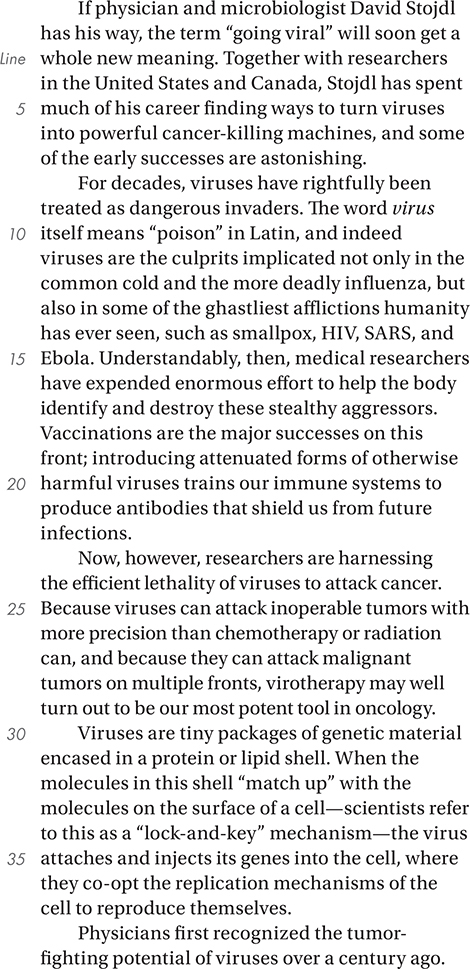
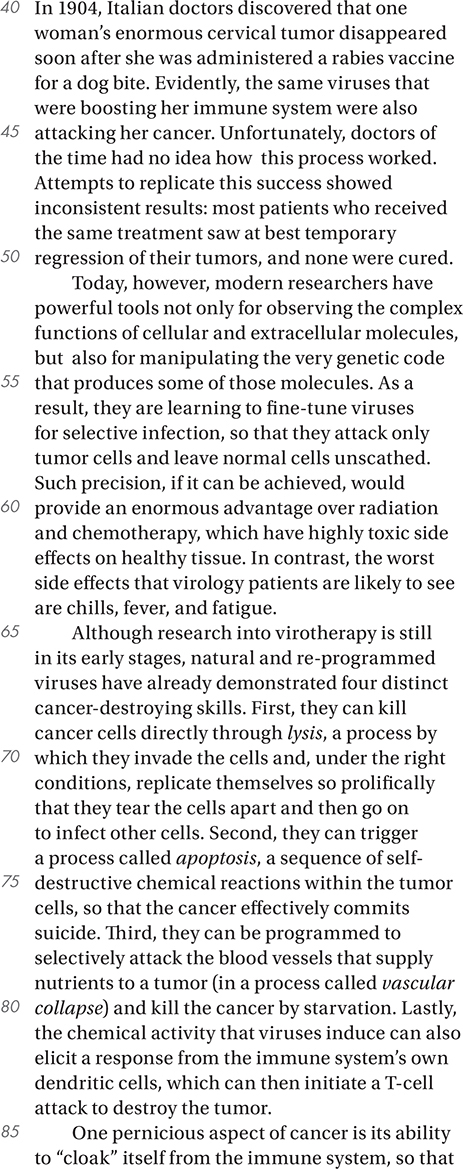

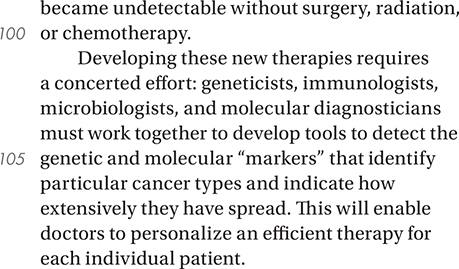
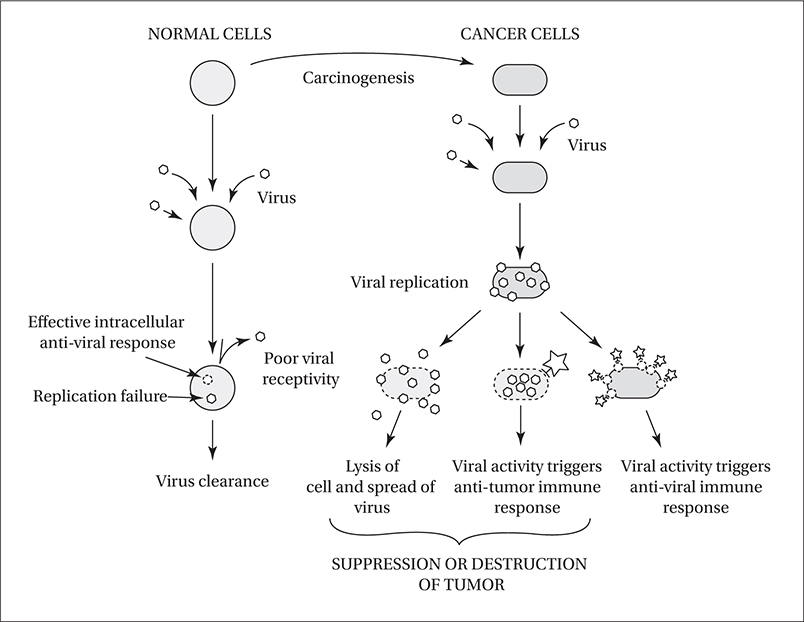
The second paragraph (lines 8–22) serves mainly to
A) relate a point of view toward viruses that contrasts with that adopted by modern microbiologists.
B) provide some technical information pertaining to virotherapy in order to clarify the discussion that follows.
C) describe several insidious diseases the treatments for which serve as a model for virotherapy.
D) illustrate the early failures of virotherapy that modern physicians have since overcome.
The passage indicates that HIV and leukemia are similar in that both
A) can be effectively treated through virotherapy.
B) are caused by viral infection of healthy cells.
C) can be treated by reinforcing the immune system.
D) can be used as treatments for other diseases.
In line 19, “front” most nearly means
A) façade.
B) campaign.
C) beginning.
D) bearing.
According to the information in the passage, the “poor viral receptivity” illustrated in the diagram is most likely due to
A) a failure of the “lock-and-key” mechanism.
B) a “cloaking” of the cell against T-cell attack.
C) the triggering of apoptosis.
D) the toxic effects of chemotherapy.
The diagram illustrates all of the following processes EXCEPT
A) T-cell attack.
B) lysis.
C) selective infection.
D) apoptosis.
What potential drawback does this diagram suggest could compromise the effectiveness of virotherapy as a cancer treatment?
A) The virus may not be able to infect the cancer cell or replicate within it.
B) The immune system may eliminate the viruses before they have a chance to destroy the cancer cell.
C) The virus may cause lysis of healthy cells.
D) The virus may not spread after killing the cancer cell by lysis.
The passage indicates that, until recently, the human immune system has been unable to attack cancers cells effectively because the human immune system
A) selectively attacks and destroys viruses rather than cells.
B) cannot penetrate the blood vessels to initiate vascular collapse.
C) is compromised by therapies such as radiation and chemotherapy.
D) is thwarted by chemical defenses that cancer cells have developed.
Which choice provides the best evidence for the answer to the previous question?
A) Lines 43–45 (“Evidently . . . cancer”)
B) Lines 55–58 (“As . . . unscathed”)
C) Lines 80–84 (“Lastly . . . tumor”)
D) Lines 85–88 (“One . . . effectively”)
In line 47, “attempts to replicate” refers to acts of
A) viral reproduction.
B) therapeutic repetition.
C) scientific refutation.
D) pharmaceutical marketing.
A student claims that viruses can destroy cancer cells only by directly infecting them. Which of the following statements from the passage most directly contradicts this claim?
A) Lines 59–62 (“Such . . . tissue”)
B) Lines 68–73 (“First . . . cells”)
C) Lines 73–77 (“Second . . . suicide”)
D) Lines 77–80 (“Third . . . starvation”)
The passage suggests that the “precision” mentioned in line 59 is most likely to be achieved through
A) vaccination against viruses like rabies.
B) genetic manipulation of viruses.
C) the combination of radiation and chemotherapy.
D) the triggering of apoptosis.
Questions 43–52 are based on the following passage.
This passage is adapted from Stephen T. Asma, “Animal Spirits.” ©2013 Stephen T. Asma. Originally published in Aeon (aeon.co), February 6, 2013. In this article, Asma describes a visit to the Serengeti plains of Africa and reflects on human and animal emotions.
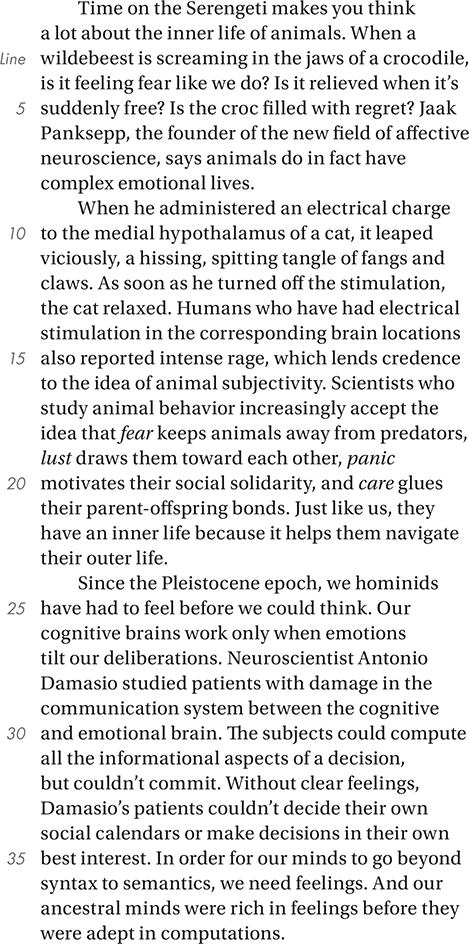
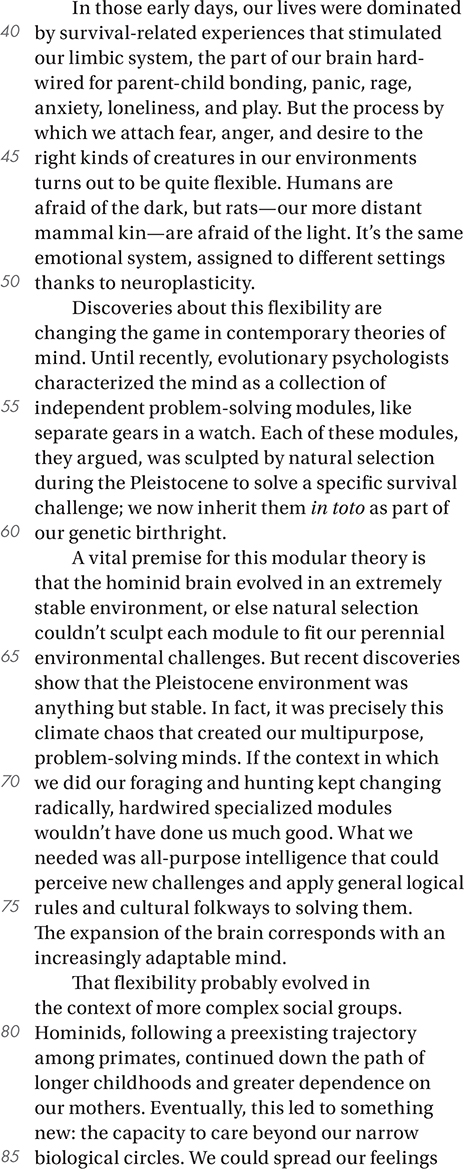
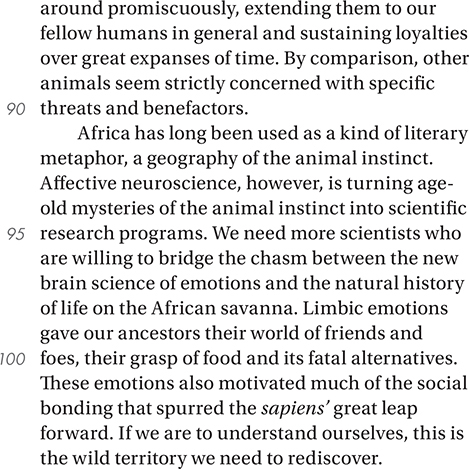
Which of the following best summarizes the main thesis of the passage?
A) We should appreciate the emotional lives of animals if we want to live sustainably with them.
B) Modern research is revealing that animals are far more intelligent than we previously believed.
C) The African savanna must be preserved so that we may continue to explore animal behavior.
D) We cannot understand human intelligence without first understanding animal emotions.
In lines 16–21 (“Scientists . . . bonds”), the sequence of words in italics represents
A) incrementally more powerful motivators.
B) progressively more speculative theories.
C) increasingly human sentiments.
D) decreasingly rational behaviors.
In line 27, “tilt” most nearly means
A) upset.
B) sway.
C) slope.
D) contend.
The passage mentions the work of Antonio Damasio primarily to
A) highlight a surprising discovery about the function of emotions in human thinking.
B) identify a setback to early research into human cognitive function.
C) illustrate a problem with drawing inferences about an entire species on the basis of a few individuals.
D) illustrate the necessity of establishing emotional relationships with research subjects.
In line 39, “those early days” refers to
A) the first stages of a child’s neural development.
B) the period before neuroscientists had access to modern diagnostic tools.
C) the epoch in which our ancestors were developing the ability to think.
D) the time when researchers first began exploring the emotional brain.
In line 64, “sculpt” refers to an act of
A) deliberate fabrication.
B) aesthetic creation.
C) theoretical refinement.
D) gradual development.
In line 76, “corresponds” most nearly means
A) coincides.
B) communicates.
C) agrees.
D) meets.
The main purpose of the sixth paragraph (lines 61–77) is to
A) explain a technical term.
B) describe an ancient habitat.
C) refute a scientific theory.
D) illustrate a psychological phenomenon.
The author objects to the theory that our brains evolved problem-solving modules, because such modules would be inconsistent with
A) the variable conditions of the Pleistocene epoch.
B) the complex emotional behaviors we share with other animals.
C) our ability to use feelings to make decisions.
D) our long childhoods and elaborate child-rearing practices.
Which choice provides the best evidence for the answer to the previous question?
A) Lines 16–21 (“Scientists . . . bonds”)
B) Lines 32–35 (“Without . . . interest”)
C) Lines 67–69 (“In . . . minds”)
D) Lines 80–83 (“Hominids . . . mothers”)
STOP
If you finish before time is called, you may check your work on this section only. Do not turn to any other section of the test.
Writing and Language Test
35 MINUTES, 44 QUESTIONS
Turn to Section 2 of your answer sheet to answer the questions in this section.
DIRECTIONS
Each passage below is accompanied by a number of questions. For some questions, you will consider how the passage might be revised to improve the expression of ideas. For other questions, you will consider how the passage might be edited to correct errors in sentence structure, usage, or punctuation. A passage or a question may be accompanied by one or more graphics (such as a table or graph) that you will consider as you make revising and editing decisions.
Some questions will direct you to an underlined portion of a passage. Other questions will direct you to a location in a passage or ask you to think about the passage as a whole.
After reading each passage, choose the answer to each question that most effectively improves the quality of writing in the passage or that makes the passage conform to the conventions of Standard Written English. Many questions include a “NO CHANGE” option. Choose that option if you think the best choice is to leave the relevant portion of the passage as it is.
Questions 1–11 are based on the following passage and supplementary material.
Careers in Engineering
1 Wherever engineers are often unfairly portrayed in the media as mere number-crunchers, we all depend on their work every day. The safety of our drinking water, the reliability of our roads and bridges, 2 how usable our smartphones are, and even the sustainability of the earth’s ecosystem all depend on the work of engineers. As we become more dependent on technologies of all sorts, engineering fields are growing quickly. 3
A) NO CHANGE
B) When
C) Although
D) Being that
A) NO CHANGE
B) the usability our smartphones have
C) the usability of our smartphones
D) our smartphones’ usability
The writer wants to add a sentence here that provides a specific and relevant detail from the graph. Which choice best accomplishes this?
A) All engineering fields are expected to grow by at least 5% per year for the foreseeable future.
B) Some engineering fields will more than double in size over the next 10 years.
C) Some engineering fields will remain stagnant over the next 10 years, while many will grow dramatically.
D) Some engineering fields are expected to grow by over 25% in the next 10 years.
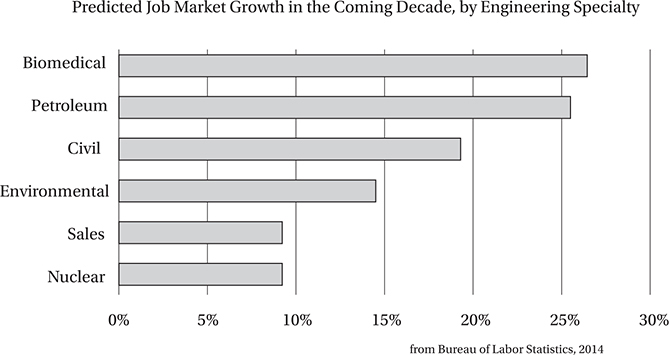
Many careers in engineering go far beyond 4 merely the application of formulas, throwing switches, and analyzing data. Although 5 a strong foundation in mathematics and science is required for all engineering careers, many also require strong skills in art, design, and the human sciences. Increasingly, technological devices don’t just need to work, they also need to work with people.
Engineering can be regarded as the science of systems. Computer software and hardware engineers analyze the systems that guide computer tasks. Industrial engineers examine the systems by which factories 6 transform raw materials and make products out of them. Civil engineers look at the systems involved in the flow of traffic, water, electricity, and communication. Environmental engineers analyze ecosystems and 7 the ways human activities impact them.
If you like to solve mathematical and physical problems and 8 seeing the tangible fruits of your labor, you should consider a career in engineering. Many entry-level engineering jobs require no higher than a bachelor’s degree in science, but higher paying jobs will likely require a professional engineer (PE) certification or master’s degree.
A) NO CHANGE
B) mere applying formulas
C) mere application of formulas
D) merely applying formulas
A) NO CHANGE
B) all engineering careers require a strong foundation in mathematics and science
C) a strong mathematics and science foundation would be required for all engineering careers
D) all engineering careers would require a strong foundation in mathematics and science
A) NO CHANGE
B) change and transform raw materials into products
C) make products out of raw materials
D) transform raw materials out of which to make new products
A) NO CHANGE
B) the ways human activity impact
C) human activity has an impact on
D) the ways by which human activities impact
A) NO CHANGE
B) like also seeing
C) like also to see
D) to see
[1] Early in life, many of us have a natural love for 9 engineering: they take apart toy cars to see how they work, or build bridges and castles out of boxes and blocks. [2] Sadly, this enthusiasm is often destroyed by schooling. [3] One solution to this problem is to expose children to fun building activities without pitting them against each other, turning the task into a performance. 10
11 We need to make engineering fun for children again, because so much depends on it. Cultures may be built by philosophers and poets, but societies are built by engineers.
A) NO CHANGE
B) engineering, they
C) engineering, we
D) engineering: we
The writer is considering adding the following sentence to this paragraph.
By forcing students to complete dull worksheets and take competitive, passion-destroying tests, schools can transform the joy of learning into misery.
The best place for this sentence is immediately
A) before sentence 1.
B) after sentence 1.
C) after sentence 2.
D) after sentence 3.
Which choice provides the most logical and effective transition to the final paragraph?
A) NO CHANGE
B) Engineering can be not only a joyful experience but also among the most lucrative careers one can have.
C) Students in Finland and Singapore score consistently at the top of international tests in math and science.
D) Like medicine, engineering is a many-faceted discipline that requires years of specialized practice.
Questions 12–22 are based on the following passage.
An American Duty
Too many American voters haven’t changed the way they 12 thought about elections since they first voted for their middle school student council. When it comes to choosing a leader, we are too influenced by his or her looks, personality, and 13 what people are saying, good and bad. Even worse, we seem to be terrible at understanding our biases and predicting the consequences of our votes, and so many of us even end up voting against our own interests.
Choosing our political leaders should be a serious task. This means that, like serious students, we should come to class 14 having done our homework, rather than merely complaining about the teacher not being entertaining enough. Our homework should be to identify the most important problems our society 15 faces, studying the mechanisms at the heart of those problems, and to determine what roles, if any, our leaders can and should play in addressing them.
Instead, we are far too lazy and far too easily manipulated. We let other 16 people—attractive news presenters, blustery radio hosts, or celebrities—tell us how we should vote, usually by giving us scary stories about the opposing party or slickly produced profiles of their favored candidates. Negative campaign ads, with
A) NO CHANGE
B) are thinking
C) have thought
D) think
A) NO CHANGE
B) what others are saying
C) their reputations
D) reputation
A) NO CHANGE
B) doing
C) having to do
D) when we did
A) NO CHANGE
B) faces, to study
C) would face, to study
D) face, studying
A) NO CHANGE
B) people who are attractive
C) people, especially attractive
D) people: attractive
ominous music playing over blurry black-and-white pictures accompanied by a threatening voice, are far too 17 valid. Responsible adults shouldn’t fall for such transparently dishonest tactics.
Instead of 18 us listening to the chattering class and blatantly biased ads, we must learn for ourselves what is going on in the world, with as few corporate or political filters as possible. 19 To that end, we should seek out reliable international newspapers and news sites with high journalistic standards, that is, those that seek more to inform than to entertain. This will give us a better perspective on both domestic and international issues.
[1] Next, we should make sure that the candidates at least understand the issues deeply, and aren’t merely reciting a political platform. [2] For instance, good representatives should be able to objectively explain, in depth, the issues plaguing the American health care system, rather than using distortions and incendiary language to smear their opponents. [3] They articulate the grievances and dynamics that drive wars and international conflicts, rather than merely posture as a “hawk” or a “dove.” 20
A) NO CHANGE
B) beneficial
C) effectual
D) credible
A) NO CHANGE
B) when we listen
C) listening
D) the listening
A) NO CHANGE
B) Alternately,
C) Notwithstanding that,
D) Nevertheless,
The writer is considering adding the following sentence to this paragraph.
Strong leaders should convey that understanding to voters, rather than merely manipulate or pander to them.
The best place for this sentence is immediately
A) before sentence 1.
B) after sentence 1.
C) after sentence 2.
D) after sentence 3.
We must also find out 21 who’s interests do the candidates really represent. Are the candidates likely to fight for large industries or common consumers? Are they strict party loyalists, or do they act and think independently? Have they pledged allegiance to any group that holds dangerous or misguided views? 22 Do they spend a lot of time in the spotlight, or do they tend to shy away from publicity?
We must answer these questions for ourselves, and not merely swallow the perspectives of radio or television personalities, no matter how blustery or attractive they might be. The strength of our democracy depends on it.
A) NO CHANGE
B) whose interests
C) who’s interests
D) about who’s interests
The writer is considering deleting this sentence to make the paragraph more concise. Should the author do this?
A) No, because it makes a new and important point about political interests.
B) No, because without it the preceding rhetorical questions do not make sense.
C) Yes, because the question is incongruous with the central idea of the paragraph.
D) Yes, because the question has already been answered in the preceding discussion.
Questions 23–33 are based on the following passage.
Idol Worship in Sports
As a source of both inspiration and relaxation, 23 human cultures have always had sports playing a central role. Correspondingly, our greatest athletes are always among our greatest icons. In ancient Greece, the wrestler Milo of Croton earned such 24 renown for his strength and skill that he was known as “The Son of Zeus.” Centuries later, 25 gladiators like Spartacus of Thrace earned a powerful following that enabled him to liberate thousands of slaves. Today, children and adults alike wear jerseys emblazoned with the names of their favorite athletes, and spend hours every week not only watching their games, but also 26 dissecting those performances later with friends.
We don’t 27 regard our most popular athletes as immortal any more, yet sports idolatry certainly doesn’t seem to have diminished much since ancient times. Most sports fans see it as a harmless, and perhaps even beneficial, pastime. What little boy doesn’t look back fondly on trying to juggle a soccer ball like Clint Dempsey or throw a split-fingered fastball like Mariano Rivera? And little girls have long aspired to be the next Serena Williams or Abby Wambach.
A) NO CHANGE
B) human cultures have always used sports in a central role.
C) sports are always playing a central role in human cultures.
D) sports have always played a central role in human cultures.
A) NO CHANGE
B) mastery
C) diligence
D) revelation
A) NO CHANGE
B) the gladiator Spartacus of Thrace
C) gladiators such as Spartacus of Thrace
D) a gladiator such as Spartacus of Thrace
Which choice best extends and completes the idea of the sentence?
A) NO CHANGE
B) learning about other sports that might be of interest
C) practicing their own athletic skills
D) going to see their performances in person
A) NO CHANGE
B) regard our most popular athletes to be
C) consider our most popular athletes as
D) consider that our most popular athletes are
Is there a cost to all of this idol worship? In fact, there are many. For one, it uses a lot of physical and mental energy, and 28 nevertheless distracts us from our tackling important issues that need our attention. An American is far more likely to be able to name all of the NFL quarterbacks than to name all of the countries in which we have an active military presence. Second, it 29 decelerates the moral fabric of our society. Well-known professional and college athletes are regularly given special treatment, even when they commit heinous crimes, like spousal abuse and felony assault, and often receive 30 just slaps on the wrist when less privileged defendants might receive lengthy prison terms.
Perhaps most damning, all of this worship doesn’t even seem to help the vast majority of the athletes themselves. According to a 2009 Sports Illustrated article, 78% of NFL players 31 have either declared bankruptcy, or suffered serious financial distress within two years of retirement. Even the most successful stars often leave the sport with long-term physical and mental deficits due to the constant physical pounding they must endure throughout their careers. This says nothing of the countless college and semi-pro players who never made it to the NFL but who nevertheless
A) NO CHANGE
B) instead
C) conversely
D) thereby
A) NO CHANGE
B) demoralizes
C) demonizes
D) degrades
Which choice best maintains the tone and style of the paragraph and adds a relevant detail?
A) NO CHANGE
B) essentially nothing to speak of
C) barely the punishment that they deserve
D) a light sentence or mere probation
A) NO CHANGE
B) have either declared bankruptcy or
C) either have declared bankruptcy, or
D) have, either declared bankruptcy, or
squandered their educations or suffered debilitating injuries 32.
We don’t live in hunting tribes anymore, so perhaps it’s time to stop acting as if we do. In our complex world, we should be valuing those who can think and care for others, not just those who can run or throw. If we need idols, why not biochemists who toil incessantly to find cures for cancer? Why not soldiers, teachers, nurses, and police who serve honorably and selflessly, usually for very little pay, 33 but they often have as much skill as the finest athletes?
At this point, the writer is considering adding the following information.
that rendered them unproductive in what should have been their prime earning years
Should this change be made?
A) Yes, because it provides an example of a particular physical injury related to playing sports.
B) Yes, because it describes the impact that sports injuries can have on the athletes’ lives.
C) No, because it mentions the years after the athletes’ sports careers, blurring the focus of the paragraph.
D) No, because it contradicts the point in the previous paragraph that athletes receive special benefits.
A) NO CHANGE
B) and with often
C) but often with
D) but often
Questions 34–44 are based on the following passage.
The Secret Life of Photons
Anyone who has gazed into the deep darkness of space on a clear, moonless night can understand why stars have always fascinated us. Ancient cultures believed that stars 34 sufficed as omens of earthly events, and even influenced individual lives through their “interactions” with the planets. To the more science-minded, they 35 have beckoned for us long with the physical mysteries behind their colossal beauty.
36 Although we now know that the stars beyond our sun are far too distant to exert any significant influence on planetary motion, let alone human affairs, it seems that modern astronomers are nevertheless exercising mystical powers of divination. Today’s astronomers claim to know the distance, age, speed,
A) NO CHANGE
B) performed
C) attended
D) served
A) NO CHANGE
B) have long beckoned us
C) have beckoned long for us
D) long have beckoned for us
A) NO CHANGE
B) Nevertheless, we know now
C) We now know
D) Now we have known
and even chemical composition of objects that are so distant we 37 might hope never to send probes there. 38 How can they claim to know so much about stars that are often millions of light years away?
It’s really an incredible feat. Consider the remarkable fact that all the information we have about stars is indirect. Unlike other objects of fascination—like microbes, the ocean floor, or even the moon—39 we can’t easily sample stars to observe them under a microscope. Instead, we must depend on the photons they emit, tiny packets of energy that must often travel thousands of billions of billions of miles or 40 more. At that point, the photons are finally absorbed by a digital camera or the retina of an eyeball that is peering through a telescope. Additionally, we
A) NO CHANGE
B) never hoped
C) would never hope
D) could never hope
The writer is considering deleting this sentence in order to make the paragraph more concise. Should this change be made?
A) Yes, because it asks a question about astronomers that has already been answered implicitly.
B) Yes, because the fact that some stars are millions of light years away has already been established.
C) No, because the question provides a logical transition to the discussion of inferential methods that follows.
D) No, because it provides an important rhetorical question about astronomy that emphasizes the author’s main thesis.
A) NO CHANGE
B) we can’t sample to make observations easily of stars
C) stars are not easily sampled for observation
D) stars are not easy to sample in observation
A) more, the photons being then
B) more when the photons are
C) more where the photons are
D) more until the photons are
can infer information about a star by looking in its neighborhood. Changes in the behavior of nearby bodies such as other stars or clouds of gas often indicate the presence of a star, 41 even when that star is too dim to see.
The light from the most distant observable 42 stars, began their journey more than 50 million years ago. In that time, the steady expansion of space itself stretched the wavelength of each photon, in a process called “redshifting.” The 43 experience of this redshifting tells astronomers how far the photon had to travel, and hence how far away the star is (or was).
The photons from a single star are not all the same wavelength, however, and that’s a good thing. The wavelengths fall into a wide 44 spectrum, which characteristics reveal the size of the star as well as the presence of elements such as hydrogen, helium, calcium, sodium, and even titanium.
Which choice best matches the style of the sentence and adds a relevant new piece of information?
A) NO CHANGE
B) which is an incredible discovery for the astronomers.
C) which is often very different in size from the nearby stars.
D) even when that gas is spinning very quickly.
A) NO CHANGE
B) stars began their
C) stars began it’s
D) stars began its
A) NO CHANGE
B) exposure
C) extent
D) expedience
A) NO CHANGE
B) spectrum that reveals by characteristics
C) spectrum, the characteristics of which reveal
D) spectrum revealing, by its characteristics
STOP
If you finish before time is called, you may check your work on this section only. Do not turn to any other section of the test.
Math Test – No Calculator
25 MINUTES, 20 QUESTIONS
Turn to Section 3 of your answer sheet to answer the questions in this section.
DIRECTIONS
For questions 1–15, solve each problem, choose the best answer from the choices provided, and fill in the corresponding circle on your answer sheet. For questions 16–20, solve the problem and enter your answer in the grid on the answer sheet. Please refer to the directions before question 16 on how to enter you answers in the grid. You may use any available space in your test booklet for scratch work.
NOTES
1. The use of a calculator is NOT permitted.
2. All variables and expressions used represent real numbers unless otherwise indicated.
3. Figures provided in this test are drawn to scale unless otherwise indicated.
4. All figures lie in a plane unless otherwise indicated.
5. Unless otherwise indicated, the domain of a given function f is the set of all real numbers for which f(x) is a real number.
REFERENCE
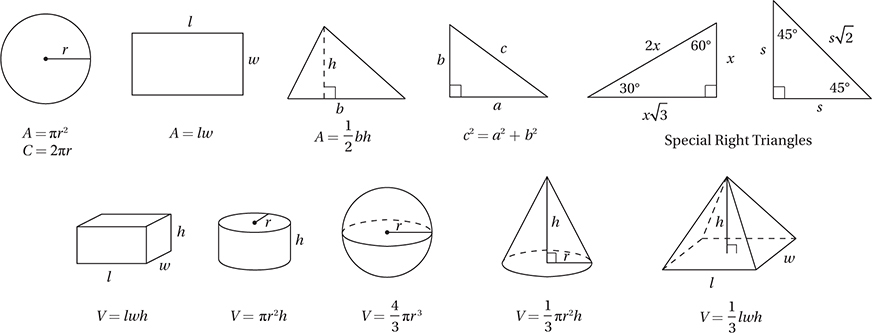
The number of degrees of arc in a circle is 360.
The number of radians of arc in a circle is 2π.
The sum of the measures in degrees of the angles of a triangle is 180.
If 2x − 3y = 9 and y = 3, then what is the value of x?
A) 0
B) 3
C) 6
D) 9
x − y = −4
x − 2y = −6
Which of the following ordered pairs (x, y) satisfies the system of equations above?
A) (−2, 2)
B) (−2, 4)
C) (4, 8)
D) (4, −8)
An information technology company estimates the cost of a project, in dollars, using the expression 240 1 3nt, where n is the number of computer servers working on the project and t is the total time, in hours, the project will take using n servers. Which of the following is the best interpretation of the number 3 in the expression?
A) Each server costs the company $3 per hour to run.
B) A minimum of 3 servers will work on the project.
C) The price of the project increases by $3 every hour.
D) Each server can work 3 hours per day.
If  , what is the value of x?
, what is the value of x?
A) 
B) 
C) 
D) 
a4 − 6a2 + 10
Which of the following is equivalent to the expression shown above?
A) (a2 − 2)(a2 − 5)
B) (a2 − 1)(a2 − 10)
C) (a2 + 3)2 + 1
D) (a2 − 3)2 + 1
In triangle ABC, angle C has a measure of 90°. If sin A = 0.6, what is the value of cos B?
A) 0.3
B) 0.4
C) 0.6
D) 0.8

If m < 0 and x = 6 in the equation above, what is the value of m?
A) −13
B) −10
C) −7
D) −3
If  and
and  , what is the value of b − a?
, what is the value of b − a?
A) −2
B) 2
C) 4
D) 8

The table above shows ordered pairs that satisfy the function f. Which of the following could define f?
A) f(b) = 3b2 − 2
B) f(b) = 3b2 − 4
C) f(b) = 2b2 − 7
D) f(b) = 2b2
The equation y = kx − 1, where k is a constant, describes a line in the xy-plane. If the graph of this line contains the point (a, b), where a and b are nonzero, what is the value of k in terms of a and b?
A) 
B) 
C) 
D) 
The equation  is true for all values of
is true for all values of  , where b is a constant. What is the value of b?
, where b is a constant. What is the value of b?
A) −12
B) −6
C) 4
D) 6
If h and k are functions such that h(x) = x + 3 and h(g(2)) = 9, which of the following could describe g(x)?
A) x2 + 2
B) x2 + 3
C) x2 + 4
D) x2 + 5
y = a(x + 3)(x − 1)
In the quadratic function above, a is a nonzero constant. The graph of the equation in the xy–plane is a parabola with vertex (m, n). Which of the following is equal to n?
A) 0
B) −a
C) −2a
D) −4a
x2 − 2ax + b = 0
In the equation above, a and b are constants. If this equation is solved for x, there are two solutions. What is the sum of these two solutions?
A) 2a
B) −2a
C) b
D) −b
Which of the following can represent the graph in the xy-plane of y = a(x − b)(x + c)2, where a, b, and c are all positive constants?
A) 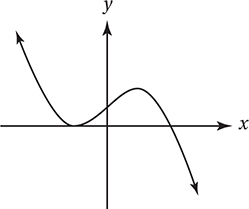
B) 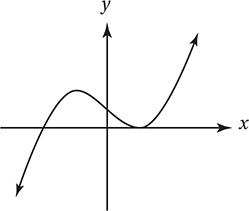
C) 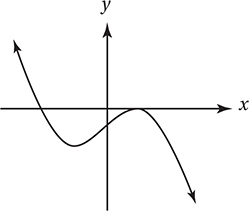
D) 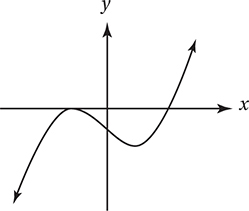
DIRECTIONS
For questions 16–20, solve the problem and enter your answer in the grid, as described below, on the answer sheet.
1. Although not required, it is suggested that you write your answer in the boxes at the top of the columns to help you fill in the circles accurately. You will receive credit only if the circles are filled in correctly.
2. Mark no more than one circle in any column.
3. No question has a negative answer.
4. Some problems may have more than one correct answer. In such cases, grid only one answer.
5. Mixed numbers such as  must be gridded as 3.5 or
must be gridded as 3.5 or  .
.
(If  is entered into the grid as
is entered into the grid as  , it will be interpreted as
, it will be interpreted as  , not
, not  .)
.)
6. Decimal answers: If you obtain a decimal answer with more digits than the grid can accommodate, it may be either rounded or truncated, but it must fill the entire grid.
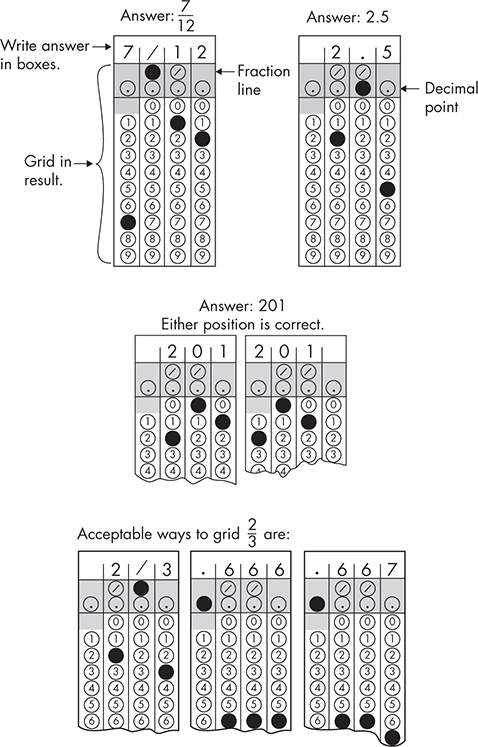
At a restaurant, each large order of fries has 350 more calories than one large soda. If 2 large orders of fries and 3 large sodas have a total of 1,500 calories, how many calories does one large order of fries have?
If  and
and  , what is the value of b?
, what is the value of b?

If x > 0, what is the solution to the equation above?
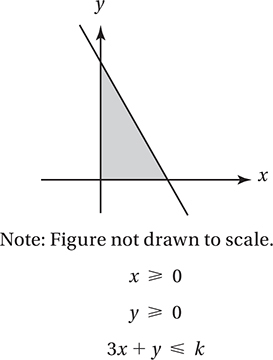
In the figure above, the shaded region represents the solution set for the system of inequalities shown. If the area of this shaded region is 24 square units, what is the value of k?
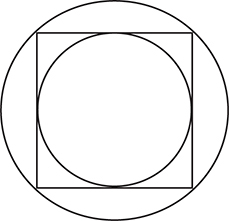
In the figure above, a circle is inscribed in a square that is inscribed in a larger circle. If the area of the larger circle is 16.5 square units, what is the area of the smaller circle?
STOP
If you finish before time is called, you may check your work on this section only. Do not turn to any other section of the test.
Math Test – Calculator
55 MINUTES, 38 QUESTIONS
Turn to Section 4 of your answer sheet to answer the questions in this section.
DIRECTIONS
For questions 1–30, solve each problem, choose the best answer from the choices provided, and fill in the corresponding circle on your answer sheet. For questions 31–38, solve the problem and enter your answer in the grid on the answer sheet. Please refer to the directions before question 31 on how to enter you answers in the grid. You may use any available space in your test booklet for scratch work.
NOTES
1. The use of a calculator is permitted.
2. All variables and expressions used represent real numbers unless otherwise indicated.
3. Figures provided in this test are drawn to scale unless otherwise indicated.
4. All figures lie in a plane unless otherwise indicated.
5. Unless otherwise indicated, the domain of a given function f is the set of all real numbers for which f(x) is a real number.
REFERENCE
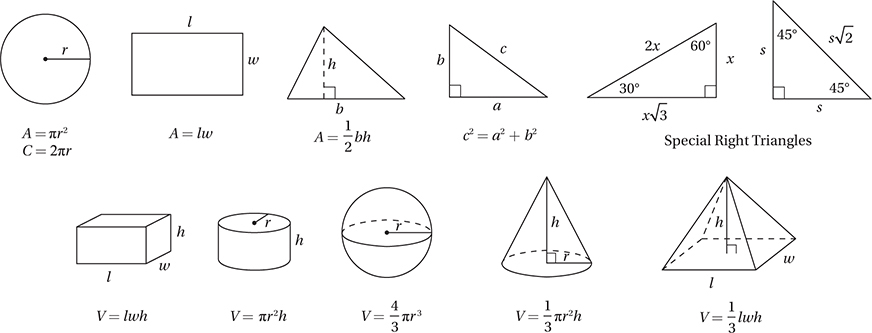
The number of degrees of arc in a circle is 360.
The number of radians of arc in a circle is 2π.
The sum of the measures in degrees of the angles of a triangle is 180.
A multiple-choice math test consists of 50 questions. Every student earns 2 points for each correct answer, 20.25 points for each incorrect answer, and 0 points for each question left unanswered. If a student answers 40 questions and gets 32 of them correct, how many points does the student earn?
A) 61.5
B) 62.0
C) 62.5
D) 64.0
If the average of 3, 5, and m is 10, what is the value of m?
A) 2
B) 6
C) 12
D) 22
If 3b + 4 = −1, what is the value of 9b + 12?
A) −8
B) −4
C) −3
D) −2
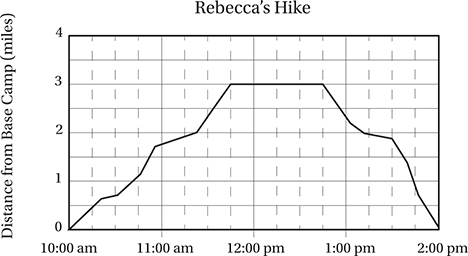
The graph above shows Rebecca’s distance from her base camp as she hiked to a mountaintop, took a 1-hour break for lunch, and returned back to base camp. According to the graph, approximately how much longer was her hike to the mountaintop than her hike from the mountaintop back to base camp?
A) 20 minutes
B) 30 minutes
C) 45 minutes
D) 60 minutes
In the 2014 season, the Bombers baseball team had a win-to-loss ratio of 5:3, with no game ending in a tie. If the Bombers played 120 total games in 2014, how many games did they lose?
A) 24
B) 36
C) 45
D) 72
3x3 − 2x2 + 5
5x2 + x − 10
Which of the following is the sum of the two polynomials shown above?
A) 8x3 − 2x − 5
B) 3x3 − x2 − 5
C) 3x3 + 3x2 + x − 5
D) 8x5 − x3 − 5
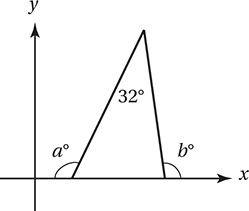
In the figure above, what is the value of a + b?
A) 212
B) 238
C) 296
D) 328
If  , where
, where  , what is the value of K?
, what is the value of K?
A) 2
B) −2
C) 2 + i
D) −2 + i

Based on the ordered pairs in the table above, which of the following could express the relationship between the variables x and y?
A) y varies linearly with, but not directly as, x.
B) y varies directly as x.
C) y varies inversely as x.
D) y varies exponentially as x.

Questions 10–12 refer to the following information.
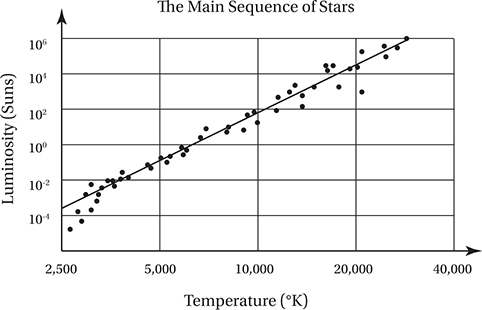
The scatterplot above charts the temperature (in degrees Kelvin) and luminosity (in Suns) for 50 stars, including our own sun, that fall under the category of “Main Sequence” stars.
The vertical axis indicates the luminosity of the stars in units called “Suns.” (A Sun unit equals the luminosity of our own sun.) According to the scatterplot, which of the following is the best estimate for the temperature of our sun?
A) 2,600°K
B) 5,800°K
C) 10,100°K
D) 12,400°K
According to the line of best fit shown on the scatterplot, a Main Sequence star with a temperature of 10,000°K is approximately how many times as luminous as a Main Sequence star with a temperature of 5,000°K?
A) 9 times as luminous
B) 90 times as luminous
C) 900 times as luminous
D) 900,000 times as luminous
What percent of the stars represented in the scatterplot have a luminosity less than 0.0001 Sun?
A) 0.2%
B) 0.4%
C) 2%
D) 4%


Given the formula above, which of the following expresses k in terms of a and b?
A) 
B) 
C) 
D) 
Which of the following functions, when graphed in the xy-plane, will intersect the x-axis exactly 3 times?
A) f(x) = (x2 + 1)(x2 + 1)
B) f(x) = (x2 − 1)(x2 + 1)
C) f(x) = x2(x2 − 1)
D) f(x) = x2(x2 + 1)
For how many distinct integer values of n is (n + 2)(n + 8) negative?
A) Four
B) Five
C) Six
D) Seven
Lauren’s car can travel d miles per gallon of gasoline. If she travels at a constant speed of s miles per hour, which of the following represents the number of hours she can travel on 6 gallons of gasoline?
A) 
B) 
C) 
D) 

If a and b are non-zero constants in the linear equation above, what is the slope of this line when it is graphed in the xy-plane?
A) 
B) 
C) 
D) 

Questions 18 and 19 refer to the following information.
P(t) = 250(2.4)t
The formula above shows the relationship between the population, P, of a certain mushroom species on a one-acre plot of land as a function of t, the number of weeks that have passed since the mushrooms were first introduced on the plot.
What is the meaning of the number 250 in the formula above?
A) The plot initially contained 250 mushrooms.
B) The population of mushrooms increases by 250 mushrooms per week.
C) The population of mushrooms increases by 250% each week.
D) It will take 250 weeks for the population of mushrooms to double.
By what percent should we expect the mushroom population to increase between the start of week 6 and the start of week 7?
A) 40%
B) 140%
C) 240%
D) 480%

If  , which of the following expressions gives both possible values of x, in terms of p?
, which of the following expressions gives both possible values of x, in terms of p?
A) 
B) 
C) 
D) 
If the variable a varies inversely as b, which of the following statements must be true?
A) a + b is a constant.
B) a − b is a constant.
C)  is a constant.
is a constant.
D) ab is a constant.
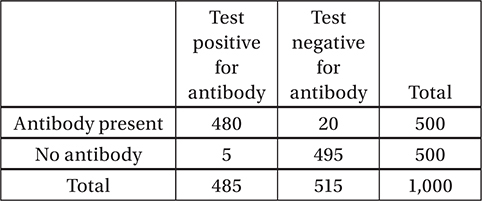
A researcher is studying the effectiveness of a method for testing the presence of an antibody in a patient’s bloodstream. The table above shows the results of 1,000 patient trials. According to these data, what is the probability that a patient who has the antibody will nevertheless have a negative test result?
A) 0.01
B) 0.04
C) 0.05
D) 0.20
Class A: 68, 79, 88, 91, 97, 98, 99
Class B: 85, 85, 85, 88, 88, 90, 90
The lists above indicate the tests scores, in increasing order, for two of Mr. Pearlman’s classes, each of which has 6 students. Which of the following correctly compares the standard deviation of the scores for each class?
A) The standard deviation of the scores in Class A is smaller.
B) The standard deviation of the scores in Class B is smaller.
C) The standard deviations of the scores in Class A and Class B are equal.
D) The relationship cannot be determined from the information given.
Mrs. Black has a bag of candy bars to hand out to the students in her class before they take their AP calculus BC exam. If she gives each student 3 candy bars, she will have 6 left over. In order to give each student 5 candy bars, she will need 50 more candy bars. How many students are in Mrs. Black’s class?
A) 18
B) 27
C) 28
D) 44
The sum of three numbers is 240. If the greatest of these numbers is 50% more than the sum of the other two, what is the value of the greatest of these numbers?
A) 96
B) 120
C) 140
D) 144
In the xy-plane, points A(2, 5) and B(−12, k) lie on a line that has a slope of  . What is the value of k?
. What is the value of k?
A) 13
B) 16.5
C) 18
D) 29.5
The original price of an outboard motor was marked down by 30% for a week-long sale. Since the motor was not sold in the first week, it was marked down an additional p percent. If the total markdown from the original price was then 58%, what is the value of p?
A) 12
B) 28
C) 40
D) 42
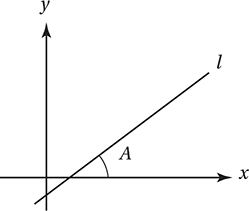
In the figure above, if cos A = 0.8, what is the slope of line l?
A) 0.60
B) 0.75
C) 0.90
D) 1.10

Questions 29 and 30 refer to the following information.
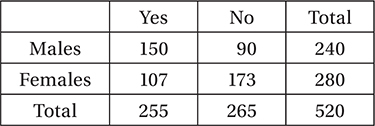
The table above shows the results of a survey of 520 adults who were asked whether they approved of a recent state budget proposal.
If n of the females had voted yes instead of no, the ratio of yes votes to no votes would have been exactly the same for the females as for the males. What is the value of n?
A) 62
B) 66
C) 68
D) 70
If this survey is representative of the entire voting population of a state in which 32,760 people are expected to vote on this budget referendum, how many males are expected to vote yes?
A) 9,450
B) 15,120
C) 19,270
D) 20,475

Student-Produced Response Questions
DIRECTIONS
For questions 31–38, solve the problem and enter your answer in the grid, as described below, on the answer sheet.
1. Although not required, it is suggested that you write your answer in the boxes at the top of the columns to help you fill in the circles accurately. You will receive credit only if the circles are filled in correctly.
2. Mark no more than one circle in any column.
3. No question has a negative answer.
4. Some problems may have more than one correct answer. In such cases, grid only one answer.
5. Mixed numbers such as  must be gridded as 3.5 or
must be gridded as 3.5 or  .
.
(If  is entered into the grid as
is entered into the grid as  , it will be interpreted as
, it will be interpreted as  , not
, not  .)
.)
6. Decimal answers: If you obtain a decimal answer with more digits than the grid can accommodate, it may be either rounded or truncated, but it must fill the entire grid.
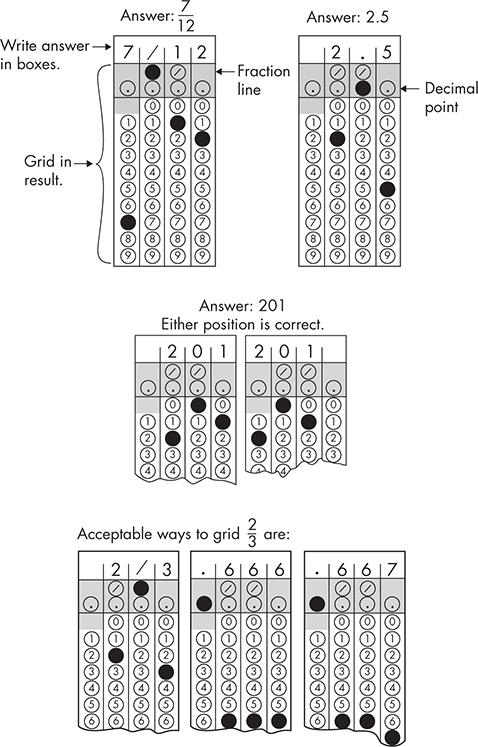
If a shipment of fruit contains 6 tons of bananas, 4 tons of grapes, 2 tons of apples, and 3 tons of oranges, what fraction of the shipment, by weight, is oranges?
A state environmental study determines that the coastal regions of the state lose 24.5 acres of wetlands per month. At this rate, how many months will it take these coastal regions to lose a total of 343 acres?
dn = 13n + 200
The formula above represents the number of donuts, dn, that a bakery sold on the nth day of a festival. If the festival lasted 3 days, what was the total number of donuts that the bakery sold during the festival?
Connor and Joachim collaborated to write a computer program that consisted of 3,500 lines of code. If Joachim wrote 600 more lines of code than Connor did, how many lines of code did Connor write?
V(t) = 1000(1 + k)m
An analyst wants to use the formula above to estimate the value, in dollars, of a $1,000 initial investment in a mutual fund after m quarters have passed. If a $1,000 initial investment in this fund is worth $1,102.50 after 2 quarters, what number should the analyst choose for k?
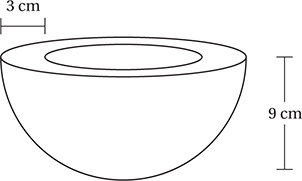
The figure above shows a hemispherical bowl made of glass. The bowl is 9 centimeters high and the glass is 3 centimeter thick. A second bowl is to be constructed to scale with the original bowl, but with one-half the height and diameter. The smaller bowl can hold a maximum of kπ cubic centimeters of water. What is the value of k? (The volume of a sphere with radius r is given by the formula  .)
.)

Questions 37 and 38 refer to the following information.

The formula above indicates the initial investment, I, that must be made in an account with an annual interest rate of r to ensure a future value of FV after a period of n years.
To the nearest dollar, what initial investment should be made in an account that earns 20% annually (r = 0.20) in order to ensure a future value of $432 in two years? (Ignore the $ sign when gridding your answer. That is, enter $125 as 125.)
What value of r, to the nearest thousandth, would ensure that the value of an investment would increase by 69% in 2 years?

STOP
If you finish before time is called, you may check your work on this section only. Do not turn to any other section of the test.
SAT PRACTICE TEST 3 ANSWER KEY
Section 1: Reading
1. D
2. A
3. D
4. C
5. C
6. B
7. C
8. A
9. C
10. A
11. B
12. D
13. D
14. B
15. A
16. A
17. C
18. C
19. C
20. B
21. B
22. D
23. C
24. A
25. A
26. A
27. B
28. B
29. C
30. C
31. A
32. A
33. C
34. B
35. A
36. D
37. B
38. D
39. D
40. B
41. D
42. B
43. D
44. C
45. B
46. A
47. C
48. D
49. A
50. C
51. A
52. C
Total Reading Points (Section 1)
Section 2: Writing and Language
1. C
2. C
3. D
4. D
5. B
6. C
7. A
8. D
9. D
10. C
11. A
12. D
13. D
14. A
15. B
16. A
17. C
18. C
19. A
20. B
21. B
22. C
23. D
24. A
25. B
26. A
27. A
28. D
29. D
30. D
31. B
32. B
33. C
34. D
35. B
36. A
37. D
38. C
39. C
40. D
41. A
42. D
43. C
44. C
Total Writing and Language Points (Section 2)
Section 3: Math (No Calculator)
1. D
2. A
3. A
4. B
5. D
6. C
7. C
8. B
9. C
10. A
11. B
12. A
13. D
14. A
15. D
-------
16. 510
17. 64
18. 6
19. 12
20. 8.25
Total Math Points (Section 3)
Section 4: Math (Calculator)
1. B
2. D
3. C
4. B
5. C
6. C
7. A
8. A
9. C
10. B
11. C
12. D
13. A
14. C
15. B
16. A
17. A
18. A
19. B
20. C
21. D
22. B
23. B
24. C
25. D
26. A
27. C
28. B
29. C
30. A
-----------------
31. .2 or 1/5
32. 14
33. 678
34. 1450
35. .05 or 1/20
36. 18
37. 300
38. .300
Total Math Points (Section 4)
SCORE CONVERSION TABLE
Scoring Your Test
1. Use the answer key to mark your responses on each section.
2. Total the number of correct responses for each section:

3. Add the raw scores for sections 3 and 4. This is your Math Raw Score: ____________
4. Use the Table 1 to calculate your Scaled Test and Section Scores (10–40).

5. Add the Reading Test Scaled Score and the Writing and Language Test Scaled Score and multiply this sum by 10 to get your Reading and Writing Test Section Score (20–80).

Table 1: Scaled Section and Test Scores (10–40)
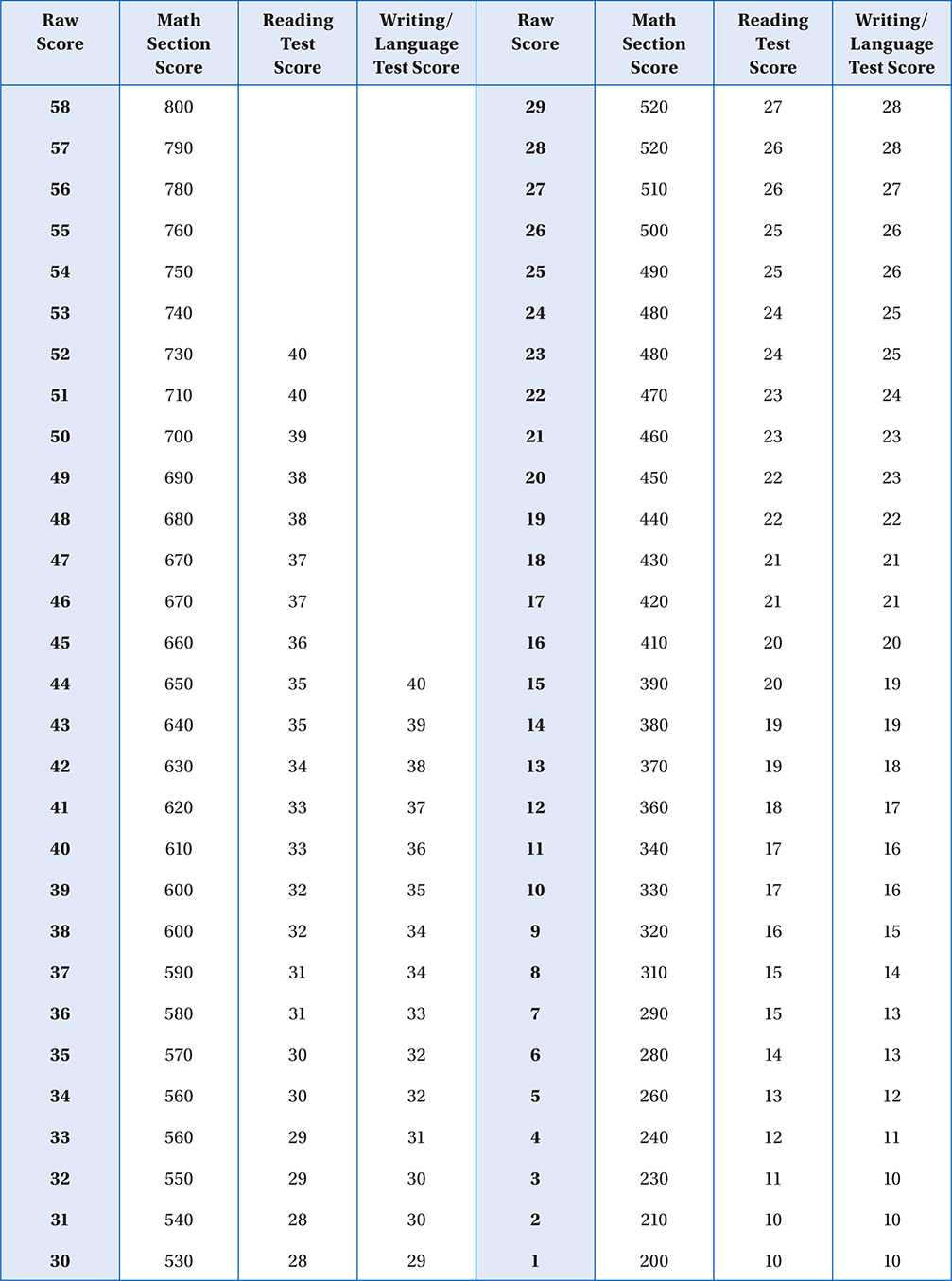
SAT PRACTICE TEST 3 DETAILED ANSWER KEY
Section 1: Reading
1. D
Purpose
The first sentence indicates what proponents of recycling assume (line 1), and the second sentence indicates what opponents [of recycling] scrutinize (lines 4–5). These sentences clearly characterize opposing viewpoints.
2. A
Interpretation
In saying Environmentalists are not all ignorant anarchists, and opponents of recycling are not all rapacious blowhards (lines 15–17), the author is establishing a counterpoint to the demonization (line 13) that plagues debates about recycling. Therefore, the author is indicating that the debaters tend to mischaracterize their opponents.
3. D
Meaning in Context
The full life cycles of various materials (lines 22–23) refers to how these materials are acquired, how they are used, and what happens to them after they have been used for industrial purposes. That is, the processes that affect the substances used in manufacturing.
4. C
Word in Context
The phrase inserting some natural resources into a responsible “industrial cycle” (lines 50–52) refers to the process of using materials in industry rather than conserving them. This is a process of introducing those materials into an industrial process.
5. C
Cross-Textual Inference
Passage 2 discusses the problem of quantifying the benefits of natural ecosystems. It mentions several such benefits, such as biodiversity, the filtration of groundwater, the maintenance of the oxygen and nitrogen cycles, and climate stability (lines 70–72). Therefore, water filtration (line 29) is clearly among these benefits.
6. B
Inference
The author of Passage 1 asks several questions that he regards to be essential to a thorough analysis of environmental policy, such as Are any materials being imported from countries with irresponsible labor or environmental practices (lines 36–38)? This indicates that the author disapproves of irresponsible labor practices such as slave or child labor. Although it may seem reasonable to think that the author of Passage 1 would support tax incentives for recycling, limits on acid rain emissions, and public investment in sustainable domestic energy sources, there is no textual evidence in Passage 1 to support any contention that he, in fact, endorses such policies. In fact, the focus on Passage 1 is on the character of the debate about environmental policy, rather than on advocating any particular position.
7. C
Textual Evidence
As the explanation to the previous question indicates, the best evidence is found in lines 36–38.
8. A
Graphical Analysis
This pie graph shows the destination of U.S. solid municipal waste in 2012. It shows that 34.5% of this waste was recycled or composted, and therefore, it shows the scale of the recycling programs discussed in Passage 1.
9. C
Cross-Textual Inference
The clear exchange mentioned in line 75 refers to the exchange with bought-and-sold commodities (lines 72–73), that is, financial expenditures. The only choice from Passage 1 that indicates a financial expenditure is the maintenance cost mentioned in line 42.
10. A
Content Analysis
Passage 1 focuses on the character of the debate between proponents of recycling (line 1) and their opponents (line 4). It refers to particular aspects of that debate, for example, the negative effects of the demonization (line 13) that each side uses to characterize its opponents. This demonization is a rhetorical strategy, that is, a persuasive technique.
11. B
Purpose
Passage 2 compares the viewpoints of environmentalists and industrialists in lines 104–108: Environmentalists argue that we cannot possibly put a price on the smell of heather and a cool breeze, while industrialists argue that the task is speculative, unreliable, and an impediment to economic progress. Previously in the passage, the author indicated that the act of put[ting] a price on the smell of heather and a cool breeze is known as quantifying “externalities” (line 77). The point in this sentence, therefore, is that careful examination of externalities is controversial, and the balance of the passage makes it clear that the author believes that this examination is necessary as well.
12. D
Purpose
In this story, the narrator describes a person who had been in the area a long time (line 1), and whom she had seen in many places, but had never spoken to. He was a mystery to the town—a monastic stranger (line 11). She describes the many hypotheses that she and the other citizens of the town had about the man and his history. Finally, in the last sentences, she meets the man and hears him speak.
13. D
Inference
The many stories about the stranger and his origins—for instance, that he was a Vietnam vet (line 9) or a Somalian refugee (lines 12–3)—were told with increasing confidence, even though they were contradictory: Eventually, the qualifying “maybes” and “perhapses” were dropped, and fiction was passed as fact (lines 14–16).
14. B
Textual Evidence
As the explanation to the previous question indicates, the best evidence is in lines 14–16.
15. A
Meaning in Context
The question Had the earth become a molten sea, a hardened moonscape surface? (lines 24–25) is part of a series of questions about the mysterious man’s past, all of which imagine that he had seen unspeakable things (line 18) and had received the scar of war (line 23). This context makes clear that this reference is to a desolate aftermath of war.
16. A
Word in Context
The phrase the character of a word in Japanese (lines 59–60) refers to the written kanji symbols in Japanese, each of which represents a word. The point here is that the mysterious stranger resembled a kanji character.
17. C
Inference
In this paragraph, the narrator says of the stranger that our paths crossed and converged daily (lines 30–31) and goes on to give several examples. Her point is that the stranger seemed to be everywhere, so these encounters are notable for their ubiquity (quality of appearing everywhere).
18. C
Stylistic Analysis
The narrator describes the stranger as a crane (lines 20 and 52) and a black crow (line 62). These are avian (bird-related) metaphors. Although the narrator speculates that the stranger is from a war-torn land, she does not use any military comparisons to describe his physical characteristics. Likewise, the passage does not use any literary allusions or exaggerated juxtapositions to describe his physical appearance.
19. C
Meaning in Context
This paragraph (lines 17–29) describes the author’s speculation that the stranger is from a war-torn land. She indicates what she “knew” about his situation: that he had run barefoot . . . through the rice paddies of Vietnam, that the earth [had] become a molten sea, and so on. Therefore, the phrase what we would all come to know most likely refers to the inhumanity of war.
20. B
Meaning in Context
When the narrator says that the stranger seemed to journey momentarily out of that dark place (lines 74–75), she is explaining how his look was clear, not shrouded with darkness not veiled with otherness as I had come to expect (lines 72–74). The darkness here is the presumed trauma that she imagines he must have experienced. Therefore, the journey the narrator believes he has taken is from grim memory to current experience.
21. B
Inference
The narrator makes it clear that she had come to expect (lines 73–74) the stranger to exude darkness (line 73) and otherness (line 73). Therefore, when the stranger greets her in a casual, upbeat way, she must have expressed surprised relief.
22. D
Characterization
The author states that the exodus of women to the cities (line 1) has ameliorated (improved) the customs and diversified the streets (lines 5–6). These are transformative effects.
23. C
Inference
The author states that New York women, and perhaps city women in general . . . are much more independent . . . and more original in their methods than women in smaller places (lines 7–11). In other words, rural women are less innovative.
24. A
Textual Evidence
As the explanation to the previous question indicates, the best evidence is in lines 7–13.
25. A
Inference
In lines 24–26, the author states that She accepts the situation [of her poverty] with the greatest good-humor and makes herself more acceptable to the old set by relating her discouragements. In other words, she considers her poverty a challenge to be embraced.
26. A
Textual Evidence
As the explanation to the previous question indicates, the best evidence is in lines 24–28.
27. B
Word in Context
The phrase done with a certain dash, élan, and sweeping air means done with a certain flair.
28. B
Meaning in Context
The sentence she makes herself more acceptable to the old set by relating her discouragements, trials, and mistakes so comically that she is better company than before (lines 25–28) indicates that the old set is a group of people that the woman knew before she moved to the city; therefore this group is a set of established acquaintances.
29. C
Inference
The passage states that the city woman who is occupied with daily work needs greater freedom of movement, more isolation, more personal comforts, and the exemption, moreover, from being agreeable at all times and places (lines 33–37). She also wants to extend hospitalities (lines 49–50) in her own home. Therefore, the author is saying that city women want to maintain their own homes primarily because they require living conditions conducive to their social independence. Choice (A) is incorrect because this passage is specifically about city women who have careers. Choice (B) is incorrect because, although the author indicates that one aspect of constructing homes is the male realization that the home is the proper stimulus to achievement (lines 47–48), she does not make any claims about homes helping women to maintain a social status comparable to that of men. Choice (D) is incorrect because the passage doesn’t indicate anything about the city woman doing work in the home, but rather retreating to her home for relaxation after work.
30. C
Thesis
The thesis of the passage is that the social independence of women (specifically, their ability to move to cities and have careers) corresponds to their desire to own and maintain a home. Choice (A) is incorrect because the passage does not discuss unfair expectations of women. Choice (B) is incorrect because the passage does not discuss housekeeping as a traditional female duty, but rather a modern sign of female independence. Choice (D) is incorrect because, although the passage does mention that city women are creative and hardworking; this is not the main thesis of the passage as a whole.
31. A
Meaning in Context
When the author states that a woman needs the exemption . . . from being agreeable at all times and places (lines 36–37), she means that city women with careers should not feel obliged to always pretend to be happy around others when they are not. Therefore, this exemption is a reprieve from a social obligation.
32. A
Purpose
The second paragraph (lines 8–22) discusses how viruses have long been characterized as dangerous invaders (line 9). However, the rest of the passage discusses the great promise that viruses hold, through immunotherapy and virotherapy, in curing diseases rather than causing them. Therefore, this paragraph serves to relate a point of view toward viruses that contrasts with that adopted by modern microbiologists.
33. C
Inference
The second paragraph mentions HIV as an example of a viral disease that could possibly be treated by vaccination, which trains our immune system to produce antibodies that shield us from future infections. In lines 96–100, the passage discusses a study showing that lymphoblastic leukemia can be particularly responsive to immunotherapy. Therefore, HIV and leukemia are both illnesses that can be treated by reinforcing the immune system. Although choice (A) may seem tempting, the passage makes it clear that vaccinations and immunotherapy work by different mechanisms than does virotherapy.
34. B
Meaning in Context
The sentence Vaccinations are the major successes on this front means that vaccinations are the major successes in this campaign [against viral diseases].
35. A
Integrated Inference
The diagram illustrates how engineered viruses used in virotherapy affect normal cells and cancer cells differently. It shows that relatively few of these viruses infect normal cells because of the poor viral receptivity of those cells. The passage indicates that the process by which viruses enter cells requires a “lock-and-key” mechanism (line 34) by which molecules on this virus shell match up with molecules on the surface of the cell.
36. D
Inference/Graphical Analysis
The diagram illustrates T-cell attack on the bottom right, where the immune response (directed by T-cells as discussed in lines 80–84) attacks cells or viruses. It also illustrates lysis (lines 69–77) at the bottom center of the diagram, where it shows a cell breaking apart from overwhelming viral infection. It also illustrates selective infection by showing that more viruses infect the cancer cells than infect the normal cells. It does not, however, show apoptosis (lines 73–76), the process by which cells commit suicide.
37. B
Graphical Analysis
The bottom right of the diagram illustrates how viral activity sometimes triggers anti-viral immune response, thereby destroying the viruses before they can kill the tumor cells. This illustrates one potential drawback that could compromise the effectiveness of virotherapy as a cancer treatment: the immune system may eliminate the viruses before they have a chance to destroy the cancer cell.
38. D
Inference
In lines 85–90, the passage states that one pernicious aspect of cancer is its ability to “cloak” itself from the immune system and to evolve proteins that kill T-cells so that the immune system can’t attack the cancer effectively. In other words, the human immune system is thwarted by chemical defenses that cancer cells have developed.
39. D
Textual Evidence
As the explanation to the previous question indicates, the best evidence is in lines 85–88.
40. B
Meaning in Context
The attempts to replicate this success (line 47) are attempts to use the rabies vaccine to kill a cancerous tumor. That is, it refers to a therapeutic repetition.
41. D
Textual Evidence
Lines 77–80 mention a way that viruses can destroy cancer cells without directly infecting them: they can be programmed to selectively attack the blood vessels that supply nutrients to a tumor . . . and kill the cancer by starvation.
42. B
Inference
The precision mentioned in line 59, as explained in the previous sentence, is the ability of viruses to selectively infect cancer cells and to leave healthy cells alone. The paragraph as a whole is discussing the powerful tools . . . for manipulating the very genetic code that produces some of those molecules [that control the interactions between cells and viruses]. Therefore, the paragraph is suggesting that genetic manipulation is the key to this kind of precision.
43. D
Thesis
The author begins the passage by ruminating about the inner life of animals (line 2). He then goes on to show how animals do in fact have complex emotional lives (lines 7–8). From the third paragraph onward, the passage focuses on the fact that we hominids [who share common ancestors with these other animals] had to feel before we could think (lines 24–25), and how our emotions affect our thinking and enable us to build and manage large social groups. Therefore, the thesis of the passage as a whole is that we cannot understand human intelligence without first understanding animal intelligence.
44. C
Purpose
The series of statements—fear keeps animals away from predators, lust draws them toward each other, panic motivates their social solidarity, and care glues their parent-offspring bonds (lines 18–21)—is intended to indicate more precisely how animals have complex emotional lives (lines 7–8) because emotion helps them navigate their outer life (lines 22–23) just as it does for humans. Therefore, the series of italicized words represents increasingly human sentiments.
45. B
Meaning in Context
The statement that our cognitive brains work only when our emotions tilt our deliberations means that our emotions sway (influence) our rational thought processes.
46. A
Purpose
Antonio Damasio’s work described in lines 32–35 shows how damage to the emotional systems of the brain can compromise decision-making. Since this discovery contradicts long-held beliefs about the distinction between reason and emotion, it highlights a surprising discovery about the function of emotions in human thinking.
47. C
Inference
The phrase those early days (line 39) refers to the Pleistocene epoch (line 24) mentioned in the previous paragraph, when our hominid ancestors lived and were evolving modern human brains. Therefore, this phrase refers to the epoch in which our ancestors were developing the ability to think.
48. D
Meaning in Context
The sentence in lines 56–60 indicates that the process of natural selection needs a stable environment over a long period of time in order to sculpt each module to fit our perennial environmental challenges. This evolutionary process by natural selection is a gradual process.
49. A
Meaning in Context
The statement that the expansion of the brain corresponds with an increasingly adaptable mind means that as the human brain evolved to become larger, it also became more adaptable: the two processes coincided.
50. C
Purpose
The sixth paragraph (lines 61–77) begins by stating that a vital premise for this modular theory is that the environment in which our ancestors evolved had to be extremely stable (lines 62–63). The paragraph then goes on to mention that recent discoveries (line 65) show that this environment was, in fact, anything but stable (line 67). Therefore, this paragraph is refuting a scientific theory.
51. A
Inference
In lines 67–69, the author states that In fact, it was precisely this climate chaos, and not the climate stability assumed by the modular theory, that created our multipurpose, problem-solving minds. That is, the variable conditions of the Pleistocene epoch contradict an essential premise of the modular theory.
52. C
Textual Evidence
As the explanation to the previous question indicates, the best evidence is in lines 67–69.
Section 2: Writing and Language
1. C
Coordination
This sentence coordinates two contrasting claims, so the contrasting conjunction Although is most appropriate.
2. C
Parallelism
This sentence contains a list, so the items in that list should have the same grammatical form. Since the first two items, the safety of our drinking water and the reliability of our roads, each has the form [definite article][quality noun][prepositional phrase], only choice (C), the usability of our smartphones, has the same form.
3. D
Graphical Analysis
Choice (A) is incorrect because the graph does not show all engineering fields, and only indicates predictions for the next 10 years, not for the foreseeable future. Choice (B) is incorrect because the largest growth shown in the graph is 25%, which is not even close to doubling. Choice (C) is incorrect because the graph shows only growth, and no stagnation. Choice (D) is correct because some engineering fields, namely biomedical and petroleum, are expected to grow by more than 25% over the next 10 years.
4. D
Parallelism
This sentence includes a list and, therefore, must follow the Law of Parallelism. Since the other two phrases in the list are gerund phrases, the underlined phrase must also be a gerund phrase. This eliminates choices (A) and (C). Choice (B) is incorrect because standard idiom requires the adverb merely rather than the adjective mere.
5. B
Coordination/Voice
The underlined clause must coordinate grammatically and logically with the clause that follows. The subject of the clause that follows, many [engineering careers], does not work unless the subject of the underlined clause also includes engineering careers. This eliminates choices (A) and (C). Choice (D) is incorrect because parallelism between the clauses involves the indicative mood, require, rather than the subjunctive mood, would require.
6. C
Redundancy
The phrase make products out of [raw materials] indicates a transformative process, so the original phrasing is redundant. Choices (B) and (D) are also redundant. Choice (C) is concise and effective.
7. A
Effective Expression
The original phrasing is best. Choice (B) is incorrect because the verb impact disagrees with the subject activity. Choice (C) is incorrect because it is not a noun phrase. Choice (D) is incorrect because it is not idiomatic.
8. D
Parallelism
Parallelism requires the phrasing to solve . . . and to see.
9. D
Coordination/Pronoun Consistency
The pronoun they is inconsistent with the phrase many of us. The colon is appropriate because the second clause explains the first.
10. C
Logic/Cohesiveness
This sentence belongs immediately after sentence 2 because it indicates a specific way in which enthusiasm is often destroyed by schooling. It belongs before sentence 3 because it specifies the problem that needs to be solved.
11. A
Transitions/Cohesiveness
The original phrasing provides the most logical and effective transition because it mentions the need to make engineering fun discussed in the previous paragraph, and connects it to the reason provided in the sentence that follows.
12. D
Verb Tense
This sentence is referring to a general quality about American voters, so the verb should be in the simple present tense in order to indicate the habitual aspect.
13. D
Clear Expression of Ideas/Parallelism
Parallelism requires that this be a list of quality nouns: looks, personality, and reputation.
14. A
Verb Tense
The original phrasing is best. The participle takes the consequential aspect because it indicates a status affected by a previous action.
15. B
Parallelism
This is a list of infinitive phrases: to identify . . . to study . . . and to determine.
16. A
Coordination
The interrupting modifier must have the same punctuation before and after—in this case, dashes.
17. C
Effective Expression/Diction
The sentence that follows says that we shouldn’t fall for such transparently dishonest tactics, thereby implying that it is a problem if these techniques are too effectual.
18. C
Modifier Errors/Idiom
The original phrasing is incorrect because the clause we must learn is not logically modified by the prepositional phrase instead of us. The proper comparison requires a participial phrase to modify the main clause: Instead of listening . . . we must learn.
19. A
Coordination
The original phrasing provides the most logical transition because this sentence describes a proposed action to achieve the goal described in the previous sentence.
20. B
Development/Cohesiveness
This sentence belongs immediately after sentence 1 because it refers directly to the understanding of the issues mentioned in sentence 1.
21. B
Diction
The context requires the possessive pronoun whose rather than the contraction who’s [who is].
22. C
Development/Cohesiveness
This sentence detracts from the paragraph’s focus on the interests that the candidates represent rather than their need for publicity.
23. D
Clear Expression/Dangling Modifiers
The underlined clause must coordinate with the modifying phrase that starts the sentence. Since the source of both inspiration and relaxationis sports, not human cultures, choices (A) and (B) are incorrect. Since the sentence indicates a status due to a previous state of being, the present tense, consequential aspect is required, as in choice (D).
24. A
Clear Expression/Diction
Since the topic sentence refers to athletes as our greatest icons, the topic of this paragraph is the renown [popularity] of athletes.
25. B
Pronoun-Antecedent Agreement/Logic
This phrase must coordinate with the rest of the sentence, which uses the pronoun him to refer specifically to Spartacus. Only choice (B) provides the correct subject.
26. A
Cohesiveness
The original phrasing is the only option that extends the idea of the sentence, which is that people spend a lot of time and effort worshipping athletes.
27. A
Idiom
The proper idioms are regard as and consider to be. The only choice that is idiomatically correct is choice (A).
28. D
Logical Coordination
The predicate that follows this word indicates a consequence of squander[ing] precious brain power on trivialities. Therefore, this adverb should indicate a consequence, as with choice (D).
29. D
Diction/Clear Expression
The point the author is making here is that idol worship causes harm to our moral fabric. The best choice to indicate this effect is (D), degrades.
30. D
Tone/Style
The passage has a moralizing tone and a formal style. Choice (D) best matches this tone and style.
31. B
Commas/Parallelism
This sentence uses the parallel idiom either A or B. Choice (B) is the only one that uses parallel form as well as proper idiom.
32. B
Coherence/Development
This is an appropriate addition here because it describes the impact that sports injuries can have on the athletes’ lives and supports the main idea of the paragraph, which is that idol worship in sport doesn’t even seem to help the vast majority of the athletes themselves.
33. C
Parallelism
Parallelism requires the phrasing usually for little pay, but often with as much skill. Notice that both phrases are prepositional phrases.
34. D
Diction/Clear Expression
This word sufficed is illogical here because this sentence does not indicate that stars served any specific need for these cultures. Stars cannot perform as omens, because they are not people or mechanisms. Rather, they served as omens to ancient cultures.
35. B
Idiom/Misplaced Modifiers
In the original phrasing the idiom beckon for is used illogically, and the modifier long is misplaced. Choice (B) is the only choice that avoids both of these problems.
36. A
Coordination
The original phrasing best establishes the contrast between the two clauses in this sentence. Choice (B) indicates a contrast, but the wrong one: it implies a contrast between the previous sentence and this one, rather than between the two ideas within this sentence.
37. D
Logic/Verb Mood
The point in this sentence is that these objects of astronomical study are very far away. They are so far away that we could never hope to send probes there. The other phrasings create illogical statements.
38. C
Development/Logical Cohesiveness
This sentence should not be deleted, because this question provides a logical transition to the discussion of inferential methods that follows. The paragraph that follows answers this question very nicely.
39. C
Dangling Modifiers/Voice/
Logical Comparisons
The sentence clearly intends to compare stars to other objects of fascination. This requires that the subject of the underlined clause be stars. This eliminates choices (A) and (B). Choice (D) is incorrect because the phrase in observation is not idiomatic.
40. D
Coordination
Choice (D) most effectively joins the ideas in a logical temporal sequence.
41. A
Cohesiveness/Development
The original phrasing matches the expository and measured tone of the passage, and adds a specific detail supporting the idea that much astronomical information is gathered indirectly.
42. D
Pronoun-Antecedent Agreement/Commas
The original phrasing is incorrect because the pronoun their disagrees in number with its antecedent light. Choice (B) is incorrect for the same reason. Choice (C) is incorrect because the context requires the possessive form its rather than the contraction it’s [it is].
43. C
Diction/Clear Expression
The point of this sentence is that the amount of the redshift in the light indicates how far the light has traveled. In other words, the extent of this redshifting tells astronomers how far away the star is (or was).
44. C
Idiom
This sentence discusses how the characteristics of the spectrum indicate the size and composition of the star. Choice (C) is the only one that uses the proper idiom for this prepositional phrase.
Section 3: Math (No Calculator)
1. D
Algebra (solving equations) EASY

2. A
Algebra (linear systems) EASY
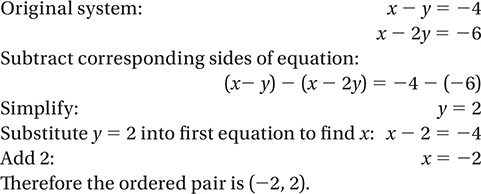
3. A
Algebra (interpreting formulas) EASY-MEDIUM
One way to analyze a formula is by “dimensional analysis.” This is simply a way to check that the units in the formula represent what they are supposed to represent. For instance, we are told that the expression 240 1 3nt represents the cost, in dollars, of the project. This means that both terms in this expression must be in dollars. Notice, also, that n is the number of servers and t is the number of hours. Let’s use a ? to represent the units of the number 3 in the expression 3nt. Translating the term into units, this gives us

In other words, it costs the company 3 dollars per hour per server.
4. B
Algebra (linear equations) EASY

5. D
Advanced Mathematics (multiplying polynomials) EASY-MEDIUM
The simplest way to approach this problem is to “expand” the choices to see which one yields an expression that is equivalent to the original expression. You must remember how to FOIL (Chapter 8, Lesson 4) when multiplying two binomials:
(A) 
(B) 
(C) 
(D) 
6. C
Additional Topics (trigonometry) EASY
It always helps to draw a diagram for geometry and trigonometry problems. For this problem, we also have to remember the basic definitions of the trigonometric functions discussed in Chapter 9, Lesson 9: SOH CAH TOA.
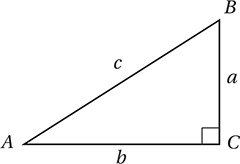
Since sin A = 0.6, this means a/c = 0.6. Notice that cos B is also a/c, so it must also equal 0.6. This is an example of the cofunction identity we discussed in Chapter 9, Lesson 10.
7. C
Advanced Mathematics (rational equations) EASY-MEDIUM
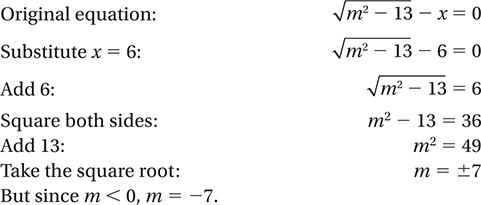
8. B
Advanced Mathematics (exponents) MEDIUM
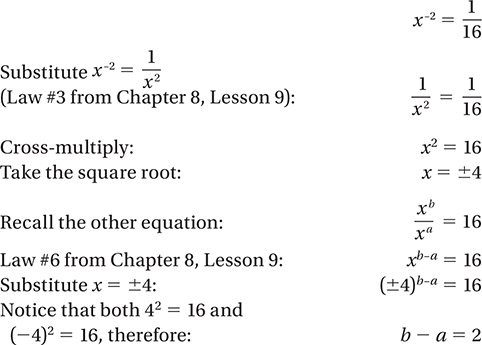
9. C
Advanced Mathematics (functions) MEDIUM
This question asks us to find the function that is satisfied by all four ordered pairs. Here, it is probably easiest to work by process of elimination, and cross off those choices that aren’t satisfied by at least one of the ordered pairs. Let’s consider the first ordered pair, (2, 1), and see which functions give an output of 1 for an input of 2:
(A) 
(B) 
(C) 
(D) 
So, it turns out we only have to test one ordered pair to get the right answer.
10. A
Algebra (linear equations) MEDIUM

11. B
Advanced Mathematics (rational equations) MEDIUM-HARD
The fact that the denominators are equal in both fractions suggests that multiplying both sides will simplify the equation:

12. A
Advanced Mathematics (functions) MEDIUM-HARD

Therefore, g must be a function that takes an input of 2 and gives an output of 6. The only choice that satisfies this condition is (A) g(x) = x2 + 2, because g(2) = (2)2 + 2 = 4 + 2 = 6.
13. D
Advanced Mathematics (analyzing quadratics) HARD
Original equation: y = a(x + 3)(x − 1)
This equation represents a quadratic in x. Since it is in factored form, it shows us that the function has x-intercepts (also known as zeroes or roots) when x + 3 = 0 or x − 1 = 0, so its x-intercepts are at x = −3 and x = 1. Recall (from Chapter 8, Lesson 6) that a parabola representing a quadratic function has an axis of symmetry at x = k, where k is midway between the x-intercepts. Therefore, k = (−3 + 1)/2 = −1. This axis of symmetry, x = −1, must pass through the vertex. We can get the y-coordinate of this vertex by just plugging x = −1 back into the function: y = a(−1 + 3)(−1 − 1)
Simplify: y = a(2)(−2) = −4a
14. A
Advanced Mathematics (solving quadratics) MEDIUM-HARD
Recall from Chapter 8, Lesson 5, that the solutions to quadratic of the form x2 + bx + c = 0, the sum of those solutions is 2b (the opposite of whatever the x coefficient is), and the product of those solutions is c (whatever the constant term is). In the quadratic x2 − 2ax + b = 0, the x coefficient is −2a. Since this must be the opposite of the sum of the solutions, the sum of the solutions is 2a.
Although using this theorem gives us a quick and easy solution, the theorem may seem a little abstract and mysterious to you. (You might want to review Lesson 5 in Chapter 8 to refresh yourself on the proof.) So, there is another way to attack this question: just choose values of a and b so that the quadratic is easy to factor. For instance, if we choose a = 1 and b = −3, we get:

The sum of these two solutions is 3 + −1 = 2.
Now we plug a = 1 and b = −3 into the answer choices and we get (A) 2, (B) −2, (C) −3, (D) 3. Clearly, the only choice that gives the correct sum is (A).
15. D
Advanced Mathematics (analyzing polynomial graphs) HARD
By the Zero Product Property (Chapter 8, Lesson 5), the graph of y = a(x − b)(x + c)2 has zeroes at x = b and a “double root” at x = −c (because this expression has two factors of (x + c)). Since b and c are both positive, this means that the graph must have one single positive root and a “double” negative root. That is, the graph passes through the x-axis at a positive value of x and “bounces” off of the x-axis at a negative value of x. Notice that this eliminates choices (B) and (C). We also know that a, the “leading coefficient” of the polynomial, is positive. If the leading coefficient of the polynomial is positive, the polynomial must eventually “shoot up” toward positive infinity; that is, it must go up as we move to the right. This rules out choice (A) and leaves only choice (D) as correct.
16. 510
Algebra (rates) EASY
Let x represent the number of calories in a large order of fries, because that is what the question is asking us to find. Since we are told that this is 350 calories more than the calories in a large soda, the number of calories in a large soda is x − 350. If 2 large fries and 3 large sodas have a total of 1,500 calories,

17. 64
Advanced Mathematics (radical equations) MEDIUM-HARD

18. 6
Advanced Mathematics (quadratic equations) HARD
Although this does not look like a quadratic equation, in fact it is.
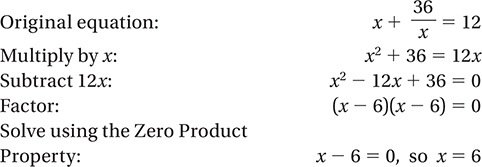
19. 12
Additional topics (coordinate geometry) MEDIUM-HARD
The system of inequalities indicates that the line containing the hypotenuse of the triangle is given by the equation 3x + y = k, which has an x-intercept of  and a y-intercept of (0, k). This means that the
and a y-intercept of (0, k). This means that the
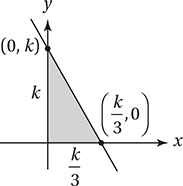
triangle has a base of  and a height of k.
and a height of k.

20. 8.25
Additional Topics (triangles, circles, and squares) HARD
Most students will begin this problem by trying to find the length of the radius of the larger circle. This is a bit of a pain and, as it turns out, completely unnecessary. Instead, start by drawing in the 45°-45°-90° triangle as shown, and notice that one leg of this triangle is the radius of the smaller circle, and the hypotenuse is the radius of the larger circle. This is the key to the relationship between the circles.
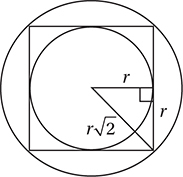
If we label the smaller leg r and use either the Pythagorean Theorem or the Reference Information about 45°-45°-90° triangles given at the beginning of the test, we find that the hypotenuse is  . Therefore, the area of the smaller circle is πr2 and the area of the larger circle is
. Therefore, the area of the smaller circle is πr2 and the area of the larger circle is  . In other words, the larger circle has an area that is twice the area of the smaller circle. Therefore, if the larger circle has area 16.5, the smaller circle has an area of 16.5 ÷ 2 = 8.25.
. In other words, the larger circle has an area that is twice the area of the smaller circle. Therefore, if the larger circle has area 16.5, the smaller circle has an area of 16.5 ÷ 2 = 8.25.
Section 4: Math (Calculator)
1. B
Algebra (word problems) EASY
For getting 32 questions correct and 40 − 32 = 8 questions wrong, the student earned 32(2) − 0.25(8) − 64 − 2 = 62 points.
2. D
Problem Solving and Data Analysis (central tendency) EASY

3. C
Algebra (linear equations) EASY

4. B
Data Analysis and Problem Solving (graphical analysis) EASY
The graph indicates that Rebecca started her hike at 10:00 a.m. and stopped for lunch at 11:45 a.m. (The horizontal segment indicates when she is not moving, so that represents her 1-hour lunch break.) This first part of her hike, therefore. took 1 hour 45 minutes, or 105 minutes. The return hike began at 12:45 and lasted until 2:00 p.m., for a time of 1 hour 15 minutes, or 75 minutes. The difference is 105 − 75 = 30 minutes.
5. C
Algebra (ratios) EASY
The win-to-loss ratio of 5:3 is a “part-to-part” ratio, so we can represent each part as a fraction of the whole. We can do this by simply adding 3 + 5 = 8 (the “whole”) and dividing by that total. This gives us a ratio of  , which means that the Bombers won
, which means that the Bombers won  of their games and lost
of their games and lost  of them. Since they played a total of 120 games, they won
of them. Since they played a total of 120 games, they won  games and lost
games and lost  games.
games.
6. C
Advanced Mathematics (adding polynomials) MEDIUM

7. A
Additional Topics (triangles) MEDIUM
It helps to mark the measures of the other two interior angles to the triangle as c° and d°, because we know something about these angles.
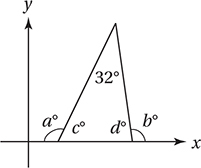
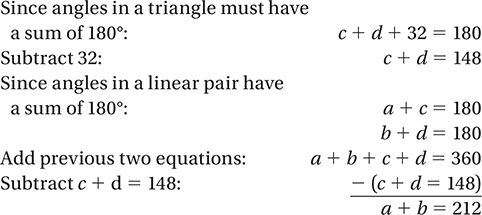
8. A
Additional Topics (complex numbers) MEDIUM

9. C
Advanced Mathematics (variation) MEDIUM
To answer this question, it helps to be familiar with the concepts we discussed in Chapter 8, Lesson 4. The first thing to notice about the ordered pairs is that as the value of x increases, the value of y decreases. More specifically, notice that the product of the two values in each ordered pair is always the same: (2)(10) = 20, (4)(5) = 20, and (10)(2) = 20. A discussed in Chapter 7, Lesson 4, this is the hallmark of an inverse variation. The equation for this particular relationship is y = 20/x.
10. B
Problem Solving and Data Analysis (scatterplots) MEDIUM-HARD
Since, by definition, the luminosity of our sun is “1 sun,” we must look for the number 1 on the vertical (“luminosity”) axis. These numbers are given as powers of 10, so we have to remember that 100 = 1. If we trace the horizontal line representing 100 lumens, we can see that it intersects the line of best fit at roughly 6,000°K. The choice that is closest to this value is (B) 5,800°K.
11. C
Advanced Mathematics (rational equations) MEDIUM-HARD
The line of best fit appears to cross the points (10,000°K, 102 suns) and (5,000°K, 10–1 suns), give or take a small error. This means that a Main Sequence star with a temperature of 10,000°K is about 102 ÷ 10–1 = 103 = 1,000 times as bright as a Main Sequence star with a temperature of 5,000°K. Choice (C) 900 is the only choice within an acceptable margin of error.
12. D
Problem Solving and Data Analysis (scatterplots) MEDIUM-HARD
First, we need to recognize that 0.0001 = 10–4. The scatterplot shows precisely two points below the 10–4 line. Since there are 50 stars represented in the scatterplot (no need to count them—the description of the graph tells us!), these two stars represent 2/50 = 4/100 = 4% of the total.
13. A
Algebra (linear equations) MEDIUM
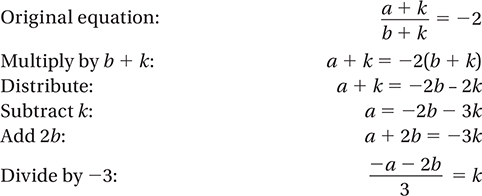
14. C
Advanced Mathematics (graphing polynomials) MEDIUM
First, notice that the answer choices include the factors x2 − 1 and x2 + 1. The first of these is a difference of squares, so it can be factored further: x2 − 1 = (x + 1)(x − 1). However, x2 + 1 is a sum of squares, which cannot be factored over the real numbers. This enables us to express each function in completely factored form:

Now we can find all of the x-intercepts by setting each factor to 0 and (if possible) solving for x. Notice that if we do this for the factored form of each function, we see that (A) has no x-intercepts, (B) has intercepts at x = 21 and x = 1, (C) has intercepts at x = 0, x = −1, and x = 1, and (D) has an intercept at x = 0. Therefore, the function in choice (C) is the only one that has three x-intercepts.
15. B
Algebra (quantitative reasoning) MEDIUM-HARD
First, we should notice the fact that n + 8 must be greater than n + 2, no matter the value of n. Next, we should notice that, in order for the product of two numbers to be negative, one of those numbers must be positive and the other one negative. Obviously, the greater number is the positive one, and the lesser one is the negative one.

Since n must have an integer value and must satisfy the inequalities above, it can take only the values −7, −6, −5, −4, and −3.
16. A
Algebra (rates) MEDIUM
Although this problem can be solved by “plugging in” convenient numbers for the unknowns, it is actually much more straightforward to treat this as a conversion problem, as discussed in Chapter 6, Lesson 4. The question gives us the “initial fact” that Lauren has 6 gallons of gas in her car, and we’d like to “convert” that fact into the number of hours she can travel. Using the rates given in the problem, the conversion should look like this:

Notice that all the units on the left-hand side cancel except for hours, which is the desired unit.
17. A
Algebra (linear equations) MEDIUM-HARD
Perhaps the best way to find the slope of the line is to get the equation into “slope-intercept form” (Chapter 6, Lesson 5).
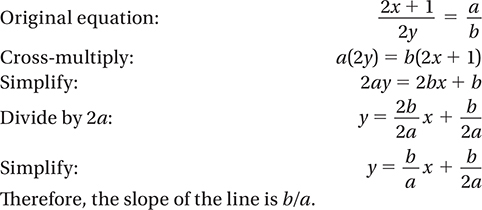
18. A
Advanced Mathematics (exponential functions) MEDIUM
Notice that substituting t = 0 into the function gives us P(0) = 250(2.4)0 = 250(1) = 250. Therefore, the number 250 in the equation means the population of mushrooms on the plot when t = 0.
19. B
Advanced Mathematics (exponential functions) MEDIUM-HARD
The fastest way to answer this question is to notice that in exponential growth and decay functions in which the exponent is the time variable, t, the base of the exponential (in this case 2.4) must represent + 1 r, where r is the rate of change per time unit. This means that the rate of weekly increase (recall that t is measured in weeks) must be 2.4 − 1 = 1.4 = 140%.
Another way to solve the problem is to calculate the populations at the specified times and then calculate the percent change. At the beginning of the sixth week, 5 weeks have passed, and so the population is 250(2.4)5 = 19,906. At the beginning of the seventh week, the population is 250(2.4)6 = 47,776. To calculate the percent change, we find the difference and divide by the initial amount: (47,776 − 19,906)/19,906 = 1.40 = 140%.
20. C
Algebra (rewriting expressions) MEDIUM-HARD
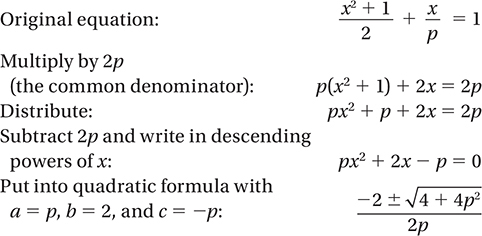
21. D
Problem Solving and Data Analysis (variation) MEDIUM-HARD
Recall from Chapter 7, Lesson 4, that if a is inversely proportional to b, then  , where k is some positive constant. If we multiply both sides of this equation by b, we get ab = k, which means that the product ab is a constant.
, where k is some positive constant. If we multiply both sides of this equation by b, we get ab = k, which means that the product ab is a constant.
22. B
Problem Solving and Data Analysis (quadratics) MEDIUM
The table indicates that a total 500 patients had the antibody and that 20 of these patients nevertheless had a negative test result. Therefore the probability of this result is 20/500 = 0.04.
23. B
Problem Solving and Data Analysis (data spread) MEDIUM
As we discussed in Chapter 7, Lesson 3, the standard deviation of a set of numbers tells us how “spread out” the data are from the average—the greater the standard deviation, the greater the spread from the average. It should be clear by inspection that the scores for Class B are more “clustered” than the scores for Class A. For instance, there is only a 5-point difference between the lowest and highest scores in Class B, but a 31-point difference between the lowest and highest scores in Class A. This means that the standard deviation of the scores in Class B is smaller.
24. C
Algebra (word problems) MEDIUM-HARD
Begin by assuming that there are n students in Mrs. Black’s class. If she gives out 3 candy bars to each student and has 6 left over, she must have 3n + 6 candy bars. If she needs 50 more candy bars in order to give each student 5 candy bars, she must have 5n − 50 candy bars. Since these two expressions both express the total number of candy bars, 3n + 6 = 5n − 50

25. D
Problem Solving (rates) MEDIUM
Let’s call the three numbers a, b, and c.

26. A
Algebra (graphs of linear equations) MEDIUM
Recall the slope formula from Chapter 6, Lesson 5:
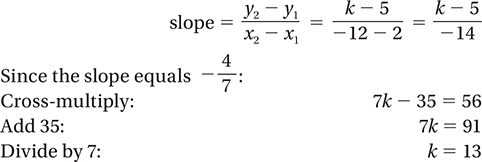
27. C
Algebra (word problems/percent change) HARD
The question makes it clear that we will get the same answer regardless of the original price of the motor. Since we are working with percentages, it is convenient to assume the original price of the motor is $100.
After a markdown of 30%, the price becomes $100 − 0.30($100) = $70. If it is marked down an additional p percent, its price becomes  . Since this is equivalent to a one-time markdown of 58%, then
. Since this is equivalent to a one-time markdown of 58%, then

28. B
Additional Topics (trigonometry/coordinate geometry) HARD
If this question gave you trouble, review Chapter 9, particularly Lessons 3, 4, and 9. Since the question asks about the slope, we should draw in a right triangle to show the “rise” and “run” of the line. If cos A = 0.8, then the adjacent side of this triangle could be 8 and the hypotenuse could be 10 (because o/h = 8/10 = 0.8) as shown below.
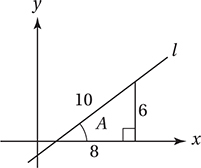
We can find the third side of the triangle with the Pythagorean Theorem (82 + x2 = 102), although it’s easier to simply notice that this is a triangle in the 3-4-5 family: 6-8-10. Since the slope of a line is the rise over the run, the slope is 6/8 = 0.75.
29. C
Problem Solving/Data Analysis (tables/ratios) MEDIUM-HARD
For the males, the ratio of yes votes to no votes is 150:90 = 5:3. If n of the females had shifted their votes from no to yes, then 173 − n would have voted no and 107 + n would have voted yes. If this ratio is then equal to the ratio for

30. A
Problem Solving/Data Analysis (tables/proportions) HARD
The table shows that 150 males voted yes out of a sample population of 520. If this is a representative ratio, and if x represents the total number of males who vote yes out of the entire population, then

31. .2
Problem Solving and Data Analysis (ratios) EASY
The total weight of the shipment is 6 + 4 + 2 + 3 = 15, and the total weight of oranges is 3, so the fraction of the shipment that is oranges is 3/15 = .2.
32. 14
Problem Solving and Data Analysis (proportions) EASY
If x is the number of months it takes until the regions lose

33. 678
Problem Solving and Data Analysis (data from formula) MEDIUM
The formula indicates how many donuts were sold on each day of the festival. One day 1, the bakery sold 13(1) + 200 = 213 donuts. On day 2, the bakery sold 13(2) + 200 = 226 donuts. On day 3, the bakery sold 13(3) + 200 = 239 donuts, for a total of 213 + 226 + 239 = 678 donuts.
34. 1450
Problem Solving and Data Analysis (rates) MEDIUM
If Connor wrote x lines of code, then Joachim wrote x + 600 lines of code. Together they wrote (x) + (x + 600) = 3,500 lines of code: x + x + 600 = 3,500

Therefore Connor wrote 1,450 lines of code.
35. .05
Problem Solving (analyzing formulas) HARD
If the investment is worth $1,102.50 after 2 quarters,

36. 18
Additional Topics (volumes and similarity) HARD
The radius of the inside of the larger bowl is 9 − 3 = 6 centimeters, so the radius of the smaller bowl is 3 centimeters. The volume of the smaller bowl is therefore  . Therefore, k = 18.
. Therefore, k = 18.
37. 300
Problem Solving and Data Analysis (formula analysis) MEDIUM
This requires simply substituting into the formula:

38. .300
Problem Solving and Data Analysis (formula analysis) HARD
If the value of the investment increases by 69% in 2 years, this means that FV = 1.691 when n = 2. Substituting into the formula gives
